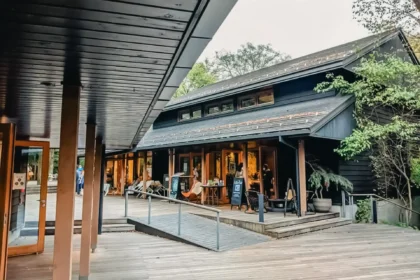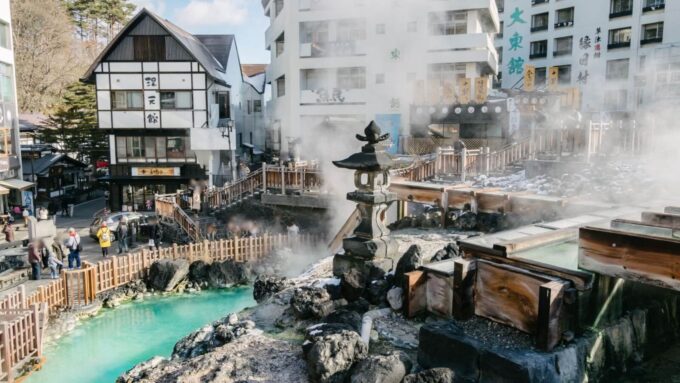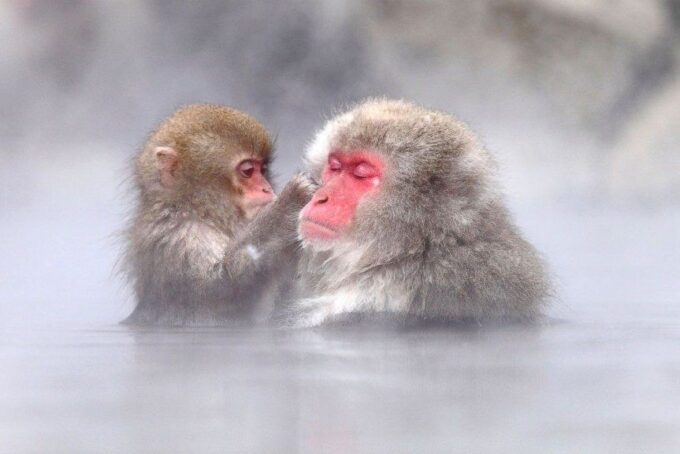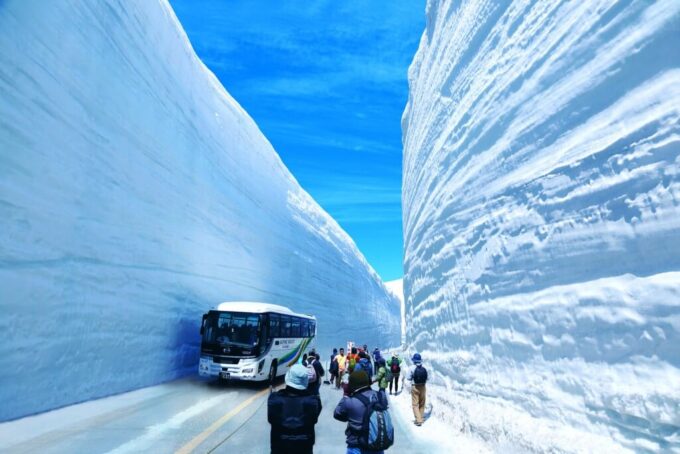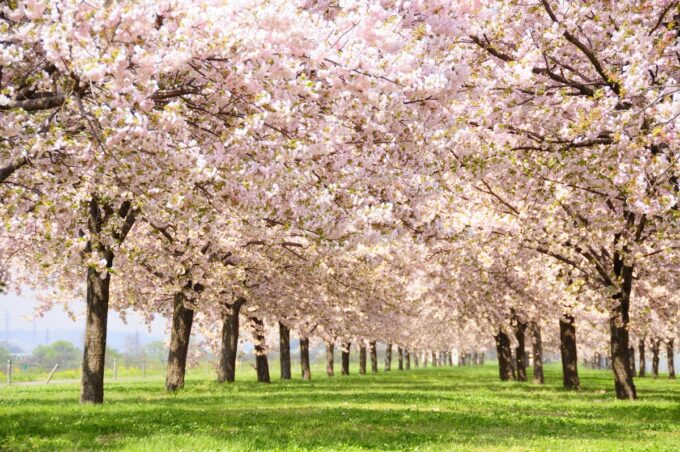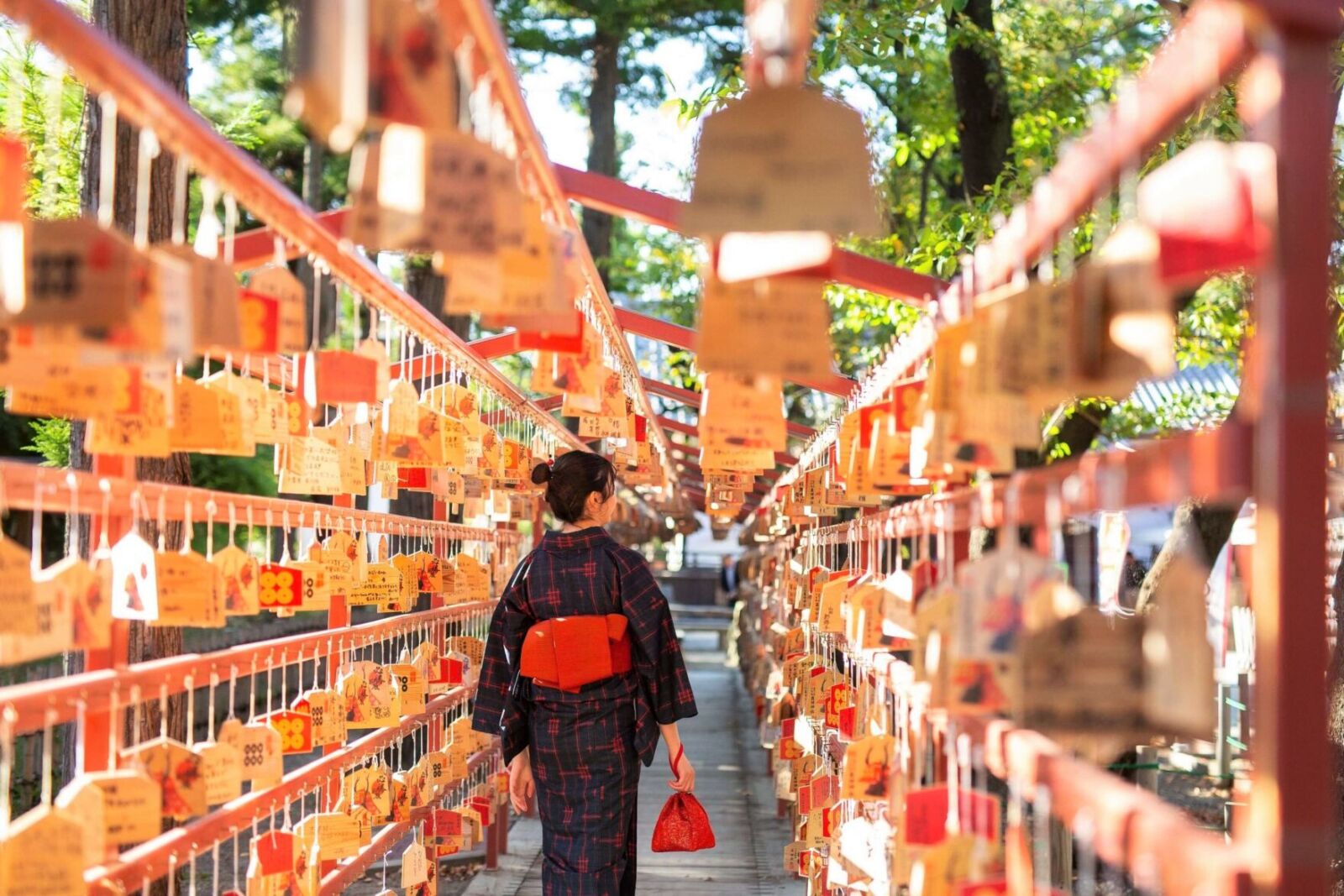
Conveniently located between Nagano and Karuizawa, Ueda and the nearby hot spring town of Bessho Onsen blend the historic with the nostalgic in creating a charming destination offering lots of little delights and surprises. On this page you will find the following information:
-- Where are Ueda & Bessho Onsen?
-- What to Expect & Why You Should Visit
-- Best Things to Do in Ueda & Bessho Onsen
-- Best Places to Stay in Ueda & Bessho Onsen
-- How to Get to Ueda & Bessho Onsen
-- Tours & Charters Around Ueda & Bessho Onsen
As the former stronghold of the legendary Sanada clan, Ueda is a historically important city that merges the past and present beautifully as local residents endeavour to preserve their traditions. A place of quaint charms and nostalgia, good food, good drink and indulgent hot springs, it may be the long-told stories of samurai that lure you to Ueda but its everything else that will make you happy you came.
WHERE ARE UEDA & BESSHO ONSEN?
Located approximately 40KM / 60 minutes drive to the south of Nagano City, Ueda is the third largest city in Nagano Prefecture. A historic and quaint city, Ueda is readily accessible from Nagano, Karuizawa, Tokyo – which lies around 210kn to the southeast – Toyama and Kanazawa thanks to the Hokuriku Shinkansen that services those and other stations. Once in Ueda, visitors will discover a historic and quaint town with lots of charm including the nearby hot spring area of Bessho Onsen. Accessible from Ueda Station using the local Bessho Line, the famous hot springs and temples of the surrounding area draw visitors from all over Japan and enjoy increasing attention from international travellers.
WHAT TO EXPECT & WHY YOU SHOULD VISIT
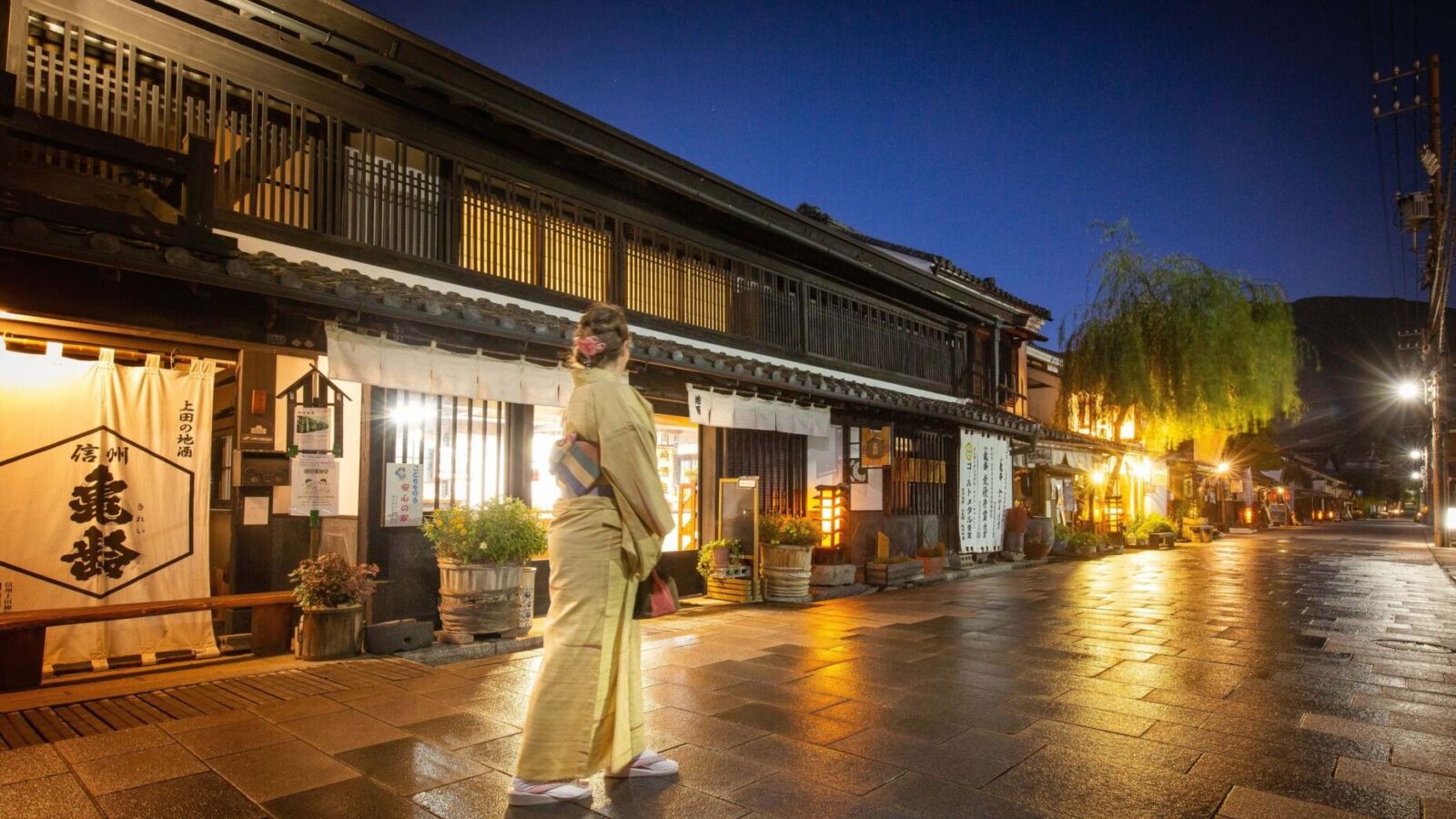
As the former stronghold of the legendary Sanada clan, Ueda is a place of true historic significance coupled with nostalgia of the more recent past. Any visit to Ueda begins at Ueda Castle Park, where visitors can walk in the shadow of the fearsome samurai that fought and repelled the equally legendary Tokugawa clan, before moving onto Yanagimachi – a popular shopping and dining street once part of the Hokkou Kaido, see below for details. Once in Ueda, visitors also discover place steeped in Showa Period (1926-1989) charm including the retro district of Fukuromachi including its beloved Ueda Eigeki cinema, the traditional sweets of Iijima Shoten and other quaint reminders of yesteryear. Nearby Bessho Onsen blends the historic and retro with pure relaxation, as one of Nagano’s best-known Showa Period hot spring towns and beautiful collection of temples. Conveniently located between Nagano and Karuizawa, Ueda and Bessho Onsen can be enjoyed as daytrips from both of those cities or most enjoyably, as an overnight / multiday visit.
BEST THINGS TO DO IN UEDA & BESSHO ONSEN
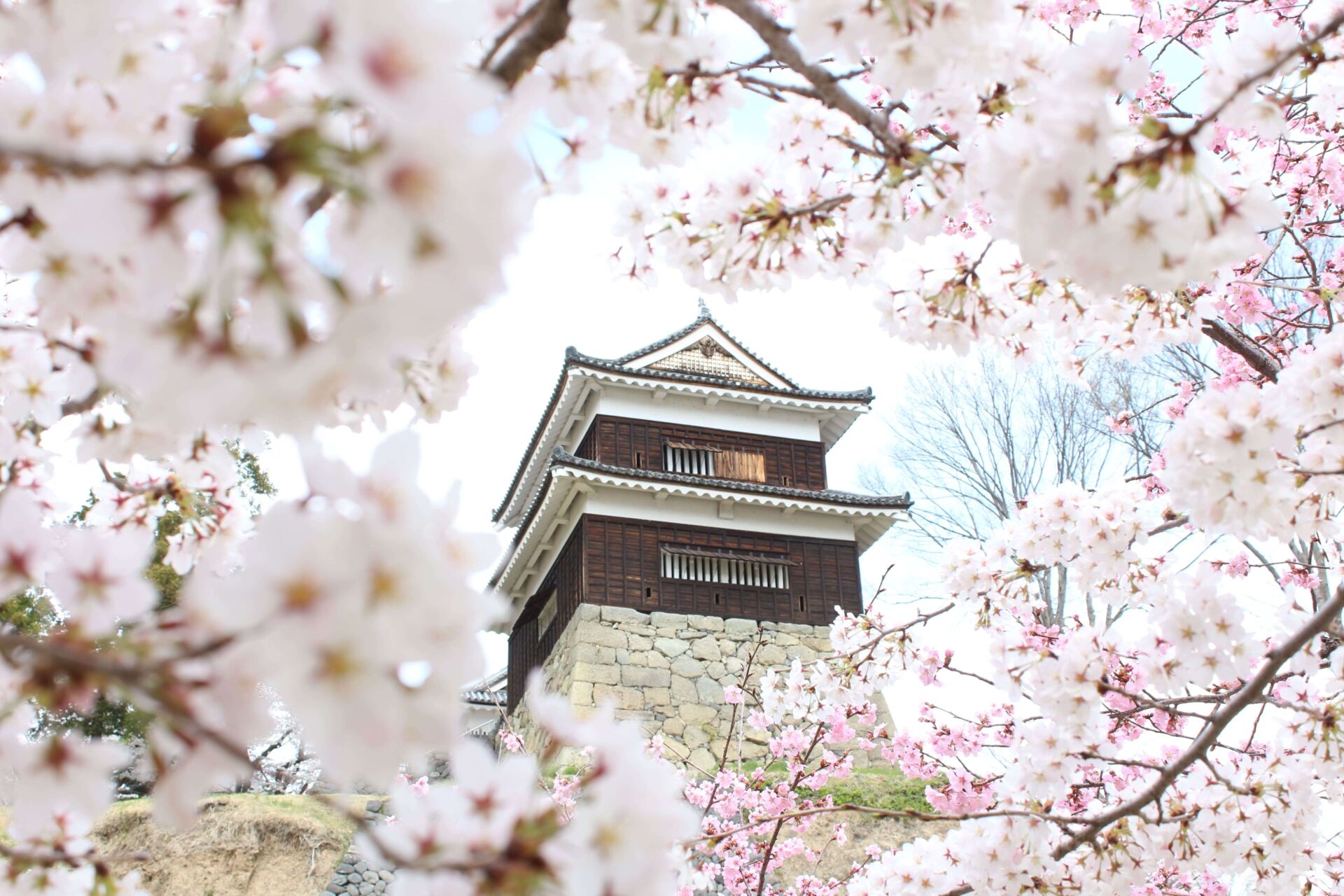
Ueda is a small, nostalgic city known for its quaint features, good food, hot springs and legendary samurai. The former stronghold of the mighty Sanada clan, any visit to Ueda starts at the expansive Ueda Castle Park before exploring its retro enclaves and side streets before heading to Bessho Onsen – Ueda’s renowned hot spring haven. Here's our recommendations of the best things to see and do in Ueda and Bessho Onsen:
1 / UEDA CASTLE PARK / all year round
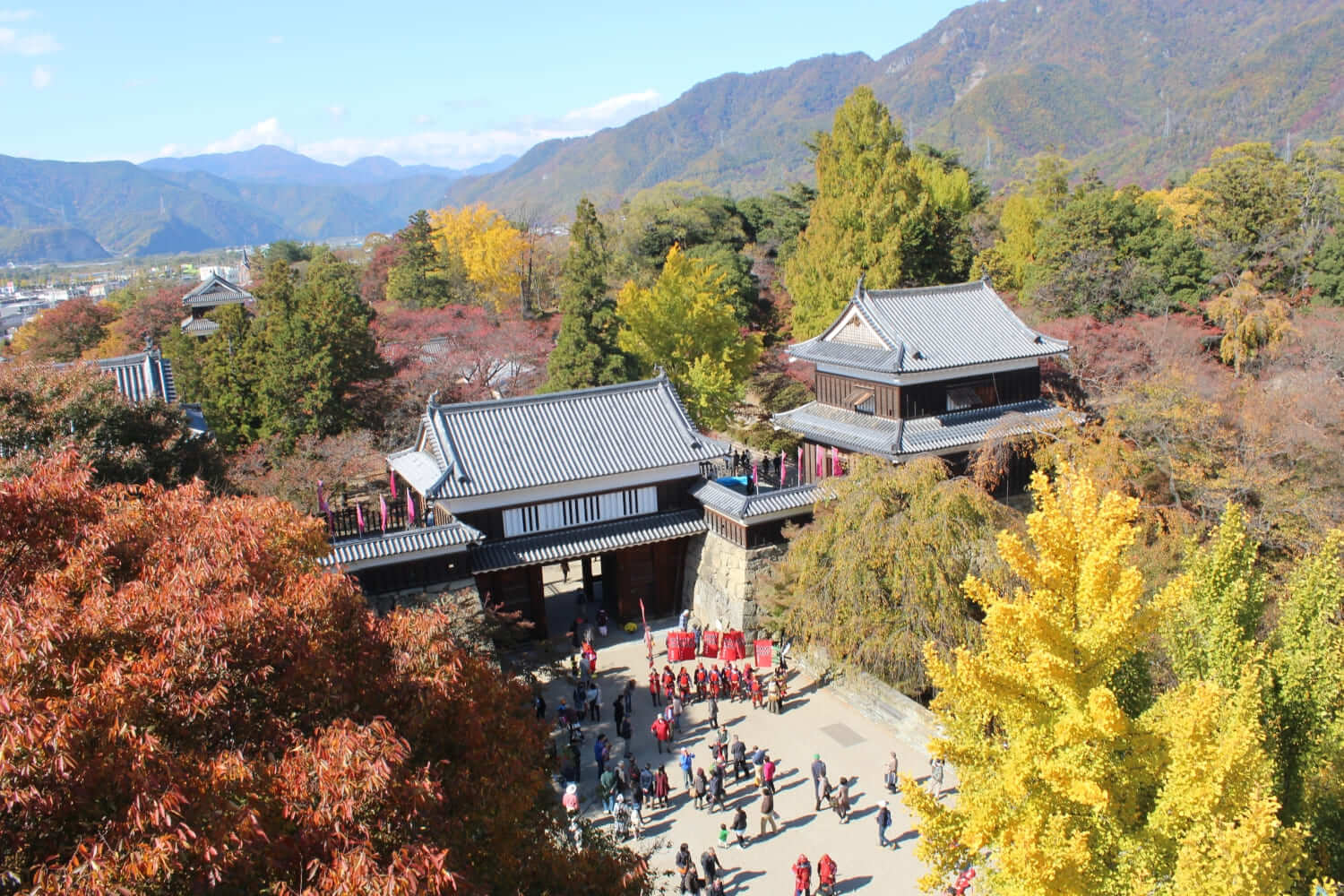
Under 15 minutes walk from Ueda Station, Ueda Castle Park is in every sense the historical heart of the Ueda. Elevated above the city by its imposing foundation walls and ringed by moats, the grounds were once part of the extensive fortifications of Ueda Castle – stronghold of the legendary Sanada clan. Built by Sanada Masayuki in 1583, the castle and its fearsome samurai twice repelled the Tokugawa clan – the clan that ultimately took control of Japan under the Tokugawa Shogunate during the Edo Period – in 1585 and 1600. In both cases, the Sanada forces were greatly outnumbered but successfully repelled the equally fearsome Tokugawa, establishing their legendary status throughout Japan.
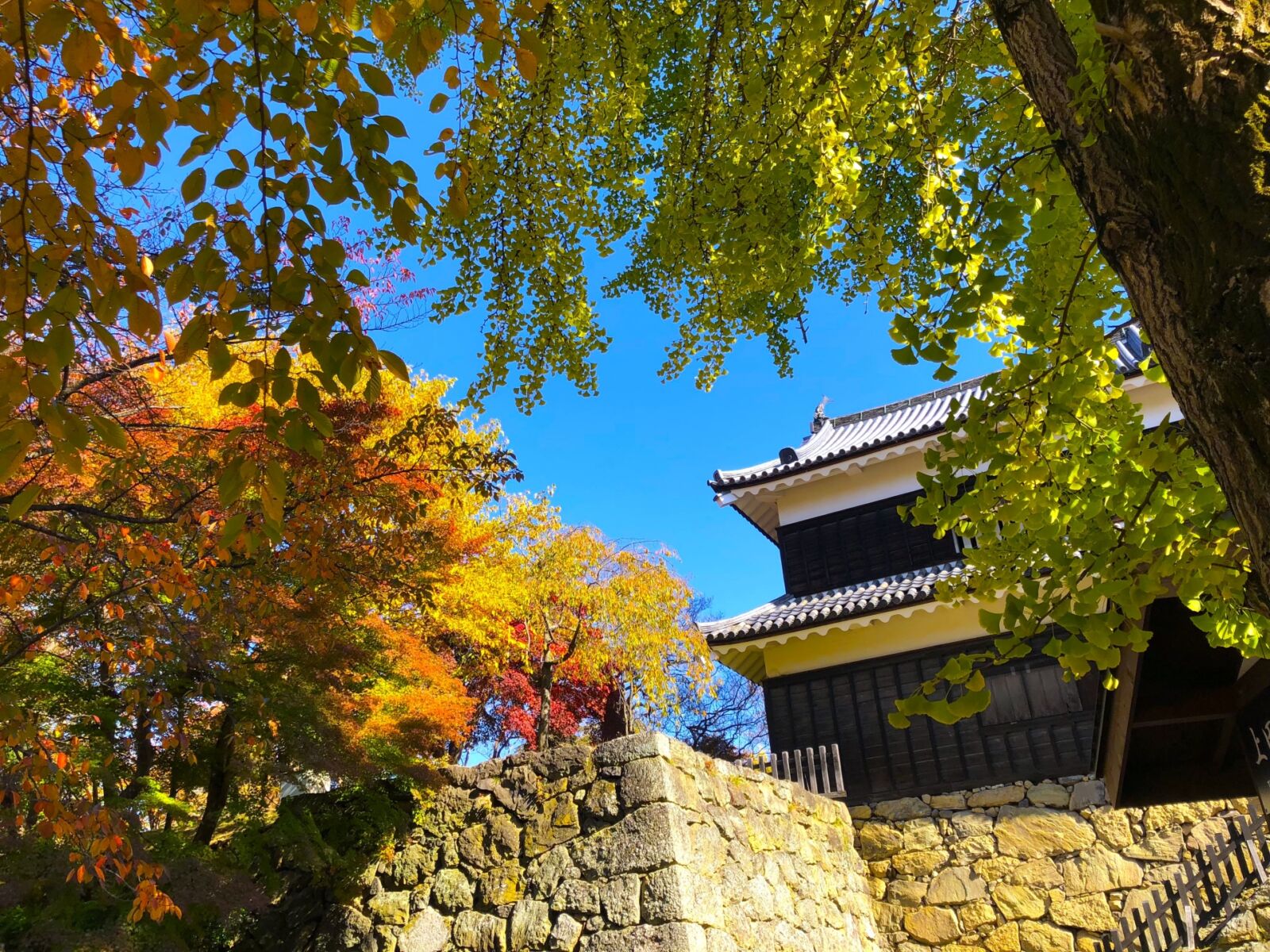
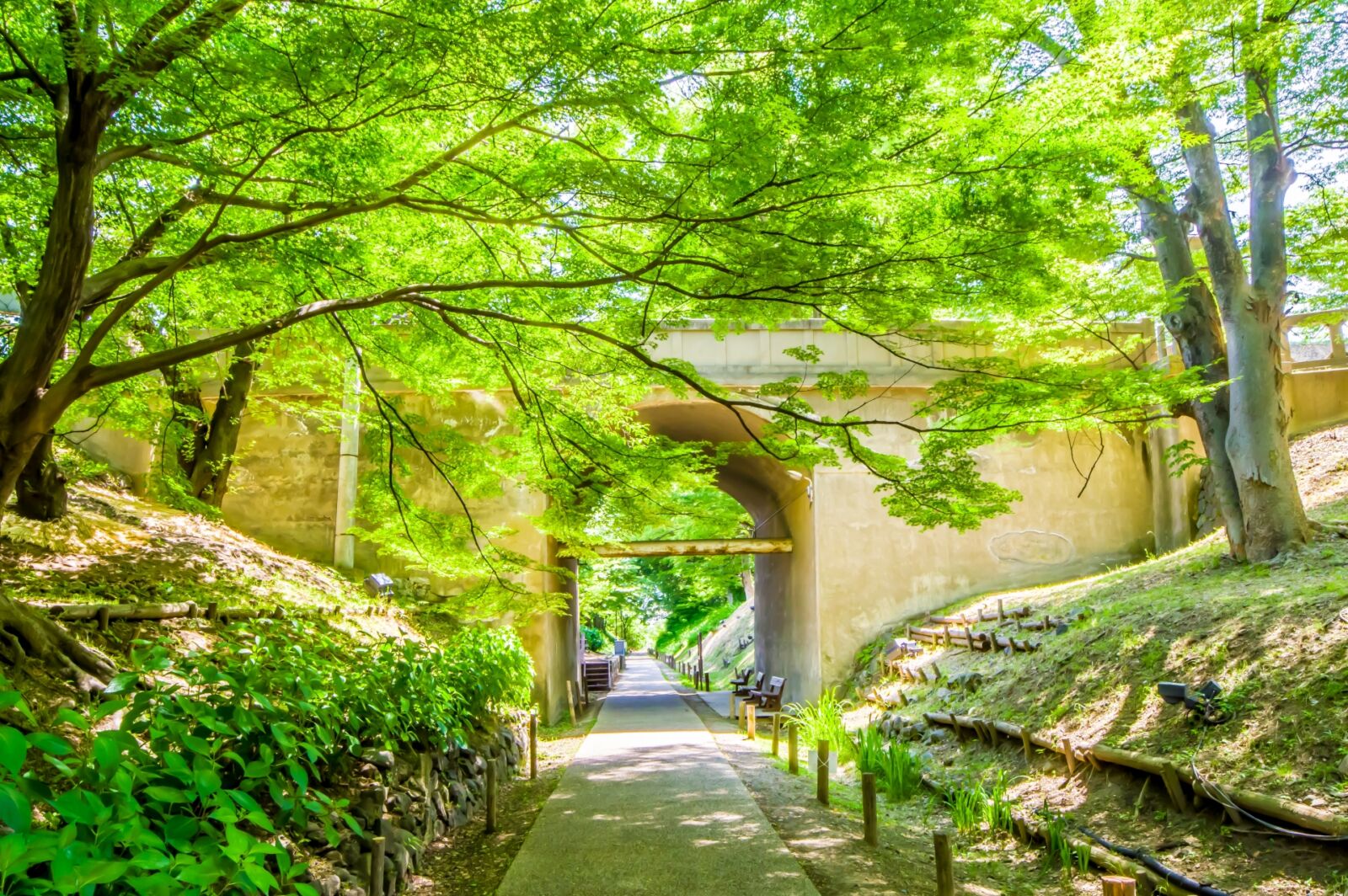
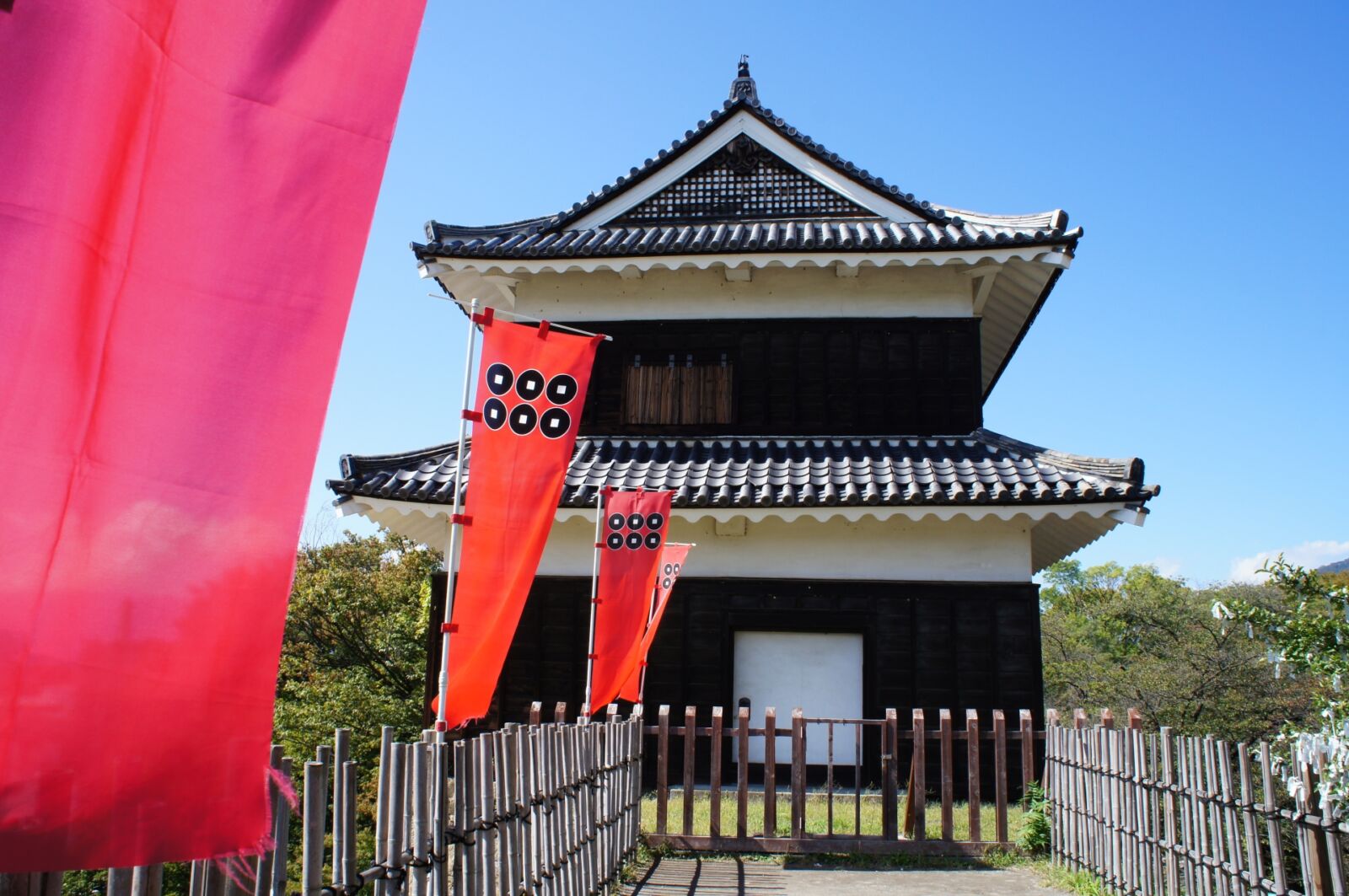

While the original castle no longer stands, the expansive park includes reconstructions of the East Gate and their defensive turrets. Other notable buildings within the park include Sanada Shrine and Ueda City Museum. Ueda Castle Park can be accessed any time of day with the approach from Ueda Station being particularly rewarding as it leads you to the southwest flank of the castle grounds, where you can see the immense original foundation walls before following the zelkova-lined avenue that takes you to the reconstruction gate. Particularly beautiful in both spring and autumn during its annual cherry blossom and autumn leaves festivals – see below for details – Ueda Castle Park remains the focal point for life in Ueda and is the ideal starting point from where to journey into the rest of the city.
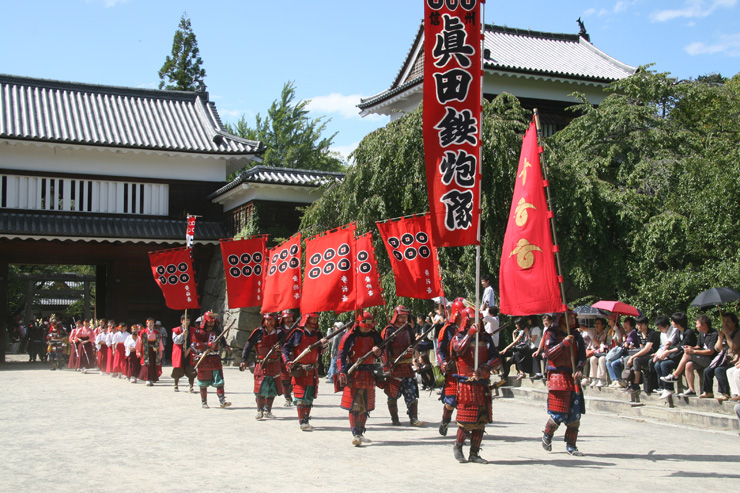
Taking place each year in November, the Ueda Sanada Festival celebrates the legendary samurai in spectacular fashion. Hundreds of participants dress in period costumes with displays of gunnery, sword-fighting and ‘taiko’ drumming drawing thousands of visitors to the castle park to watch a brilliant historical display. The festival has events throughout the day. Admission is free.
2 / STROLL, SHOP & DINE ON THE NOSTALGIC 'YANAGIMACHI' / all year round
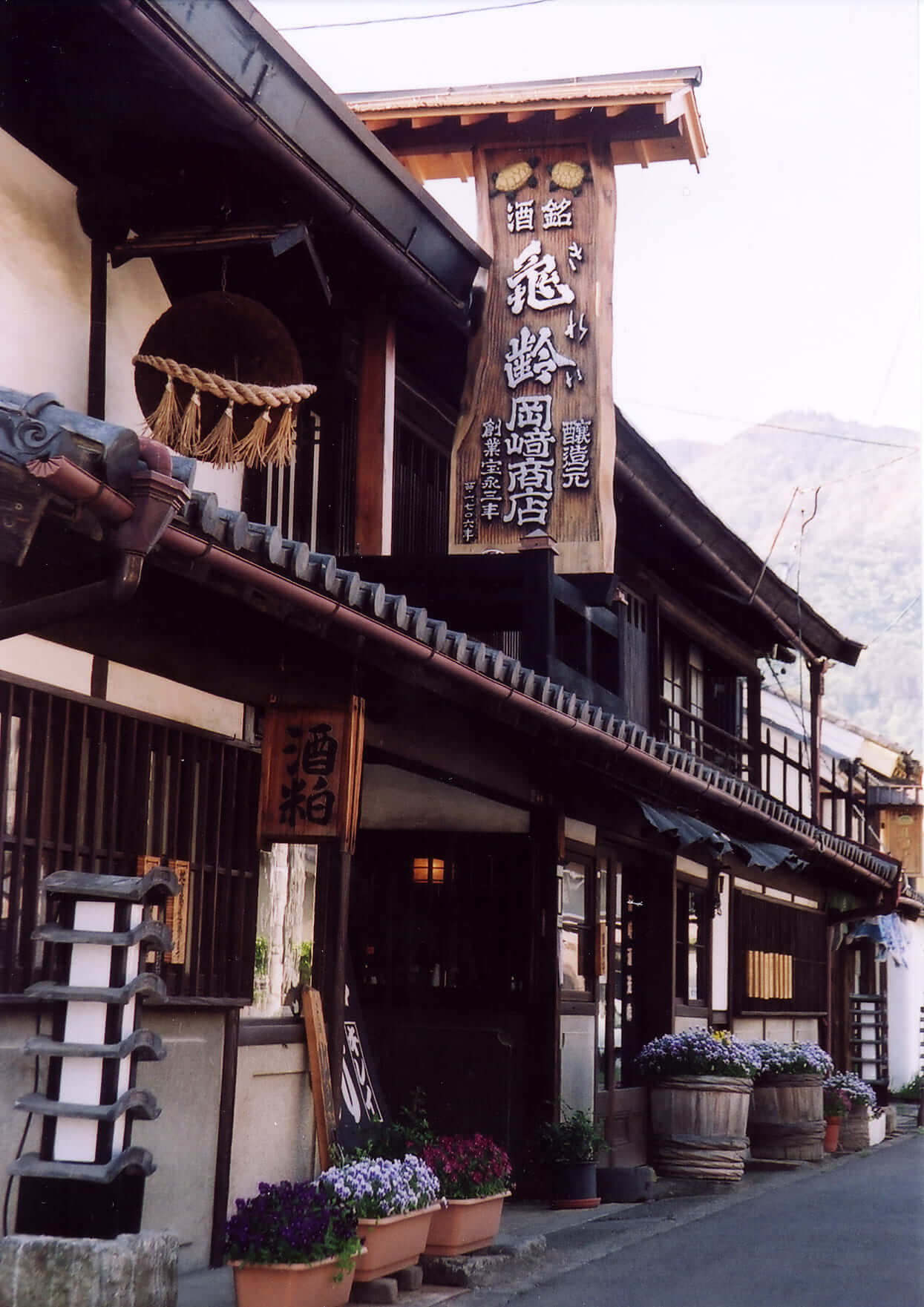
From the castle park, visitors can enjoy a leisurely 10 minute walk to the historic street of Hokkoku Kaido Yanagimachi or simply, ‘Yanagimachi’. Once part of the Hokkoku Kaido - an important trade route linking Ueda to Nagano and Niigata – Yanagimachi remains in a beautiful state of preservation thanks to the effort of local residents to retain the historic character of the street. Traditional merchant shops line the street, housing a range of stores and eateries including Okazaki Sake Brewery, Takeda Miso Brewery Hishiya, Bakery Levain and Co. Labo Shop along with soba restaurants, cafes and more. Much more than just a dining and shopping street, Yanagimachi is a great destination for keen photographers or anyone wanting a glimpse of the Japan that once was. Opening times and days vary by shop with most operating from around 10:00 to between 16:00 or as late as 18:00.
3 / TRADITIONAL FOOD, ‘SAKE’ & WINE OF UEDA / all year round
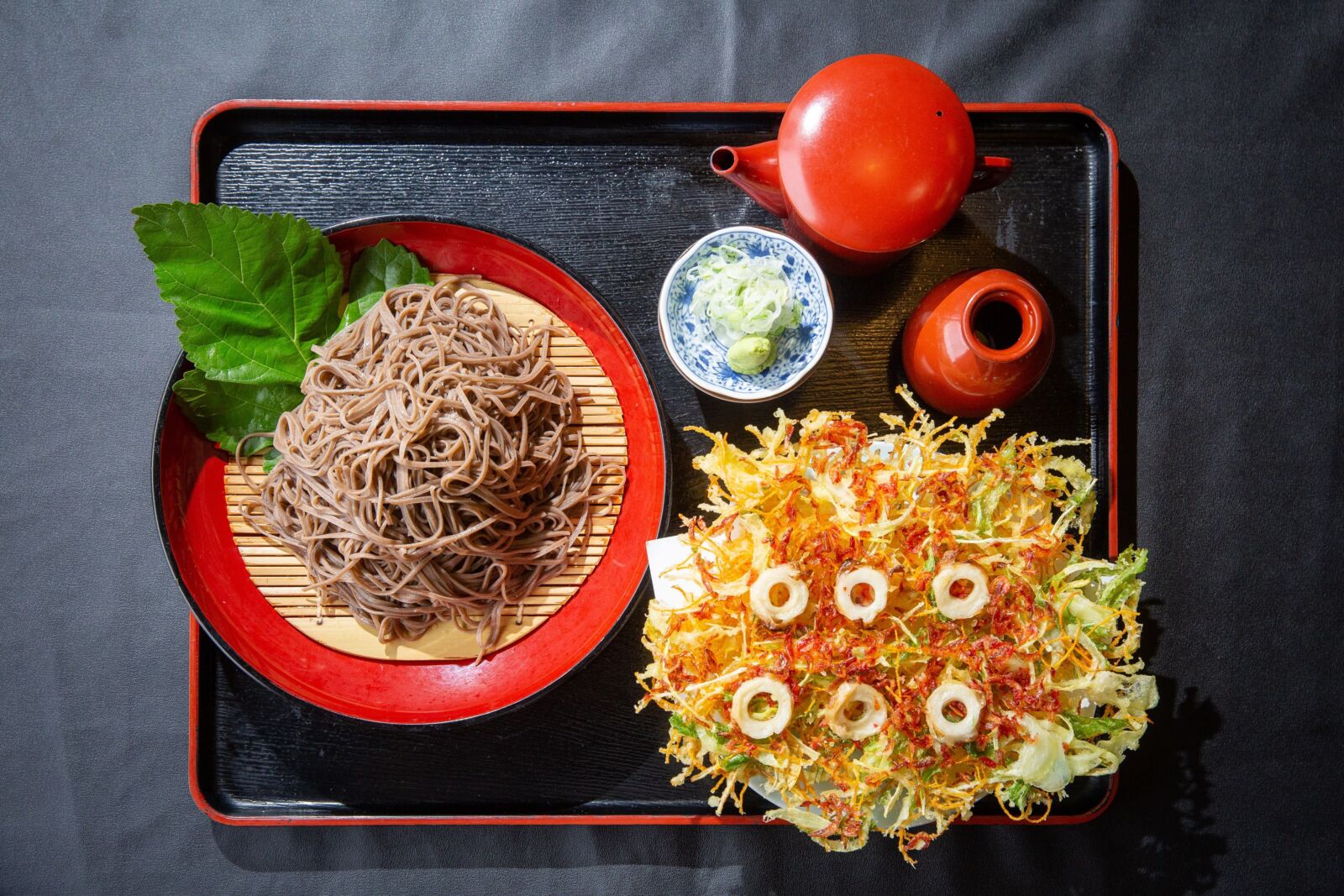
Ueda is a small city surrounded by bountiful farmlands and pristine natural landscapes. As such, it should come as no surprise that visitors to Ueda can enjoy great local cuisine all year round. The region is famous for its apples – that can be enjoyed at many eateries around the city – along with its ‘soba’ (buckwheat noodles), ‘Oidare Yakitori’ (char-broiled chicken), traditional sweets – including at Ueda’s famous Iijima Shoten – and famous ‘Ayu Ramen’. Restaurants are dotted throughout the city with Yanagimachi and Fukuromachi districts standing-out as two of the best dining areas.
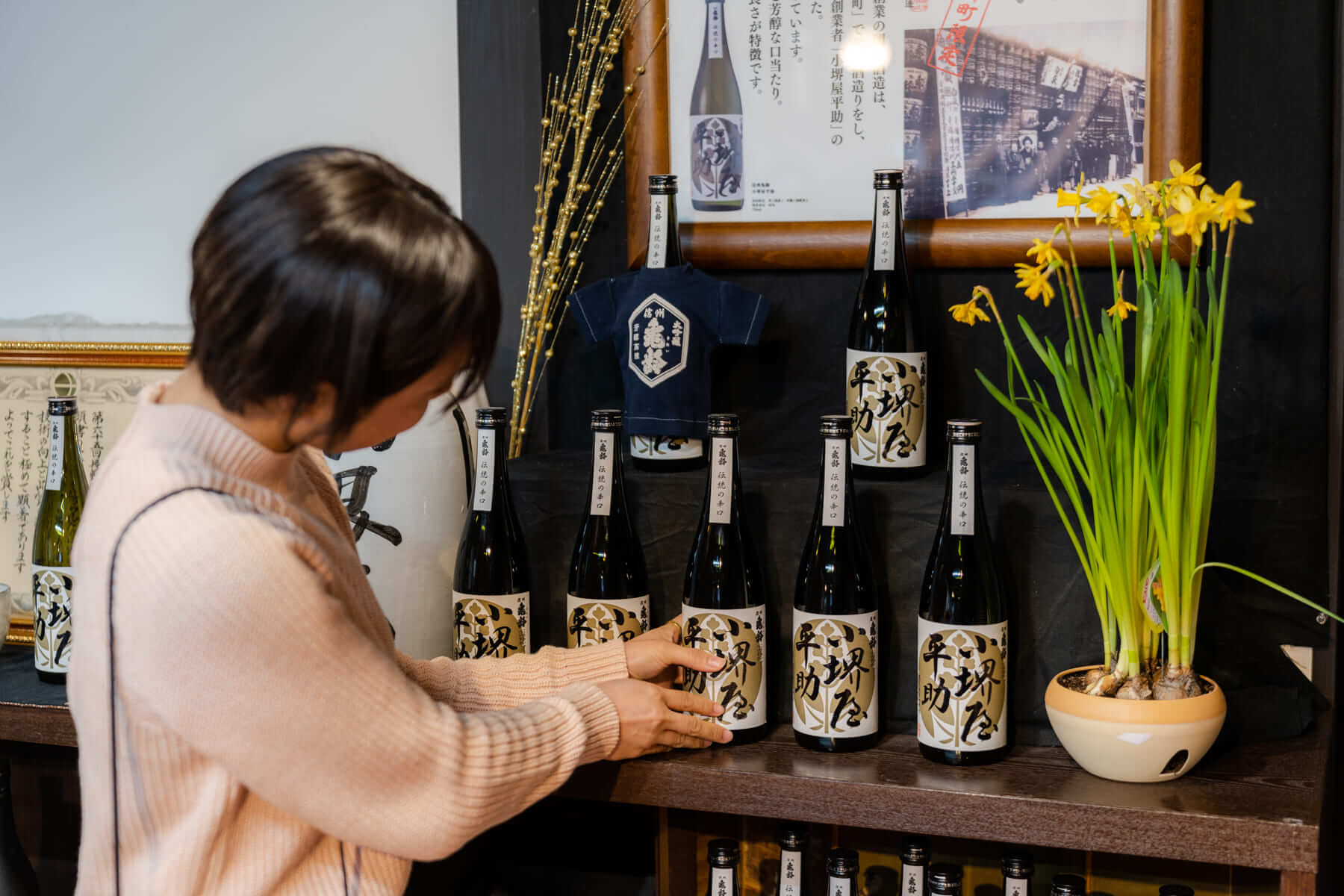
Ueda is also known for its traditional ‘sake’ and burgeoning wine industries. Okazaki Sake Brewery in the Yanagimachi district is one of Ueda’s best-known breweries, led by one of Japan’s few female ‘toji’ (master brewer), Okazaki Midori. With a history stretching back around 350 years, Okazaki Sake Brewery is one of the best in Nagano.
4 / UEDA ‘TSUMUGI’ INC. KIMONO EXPERIENCE & CRAFT / all year round
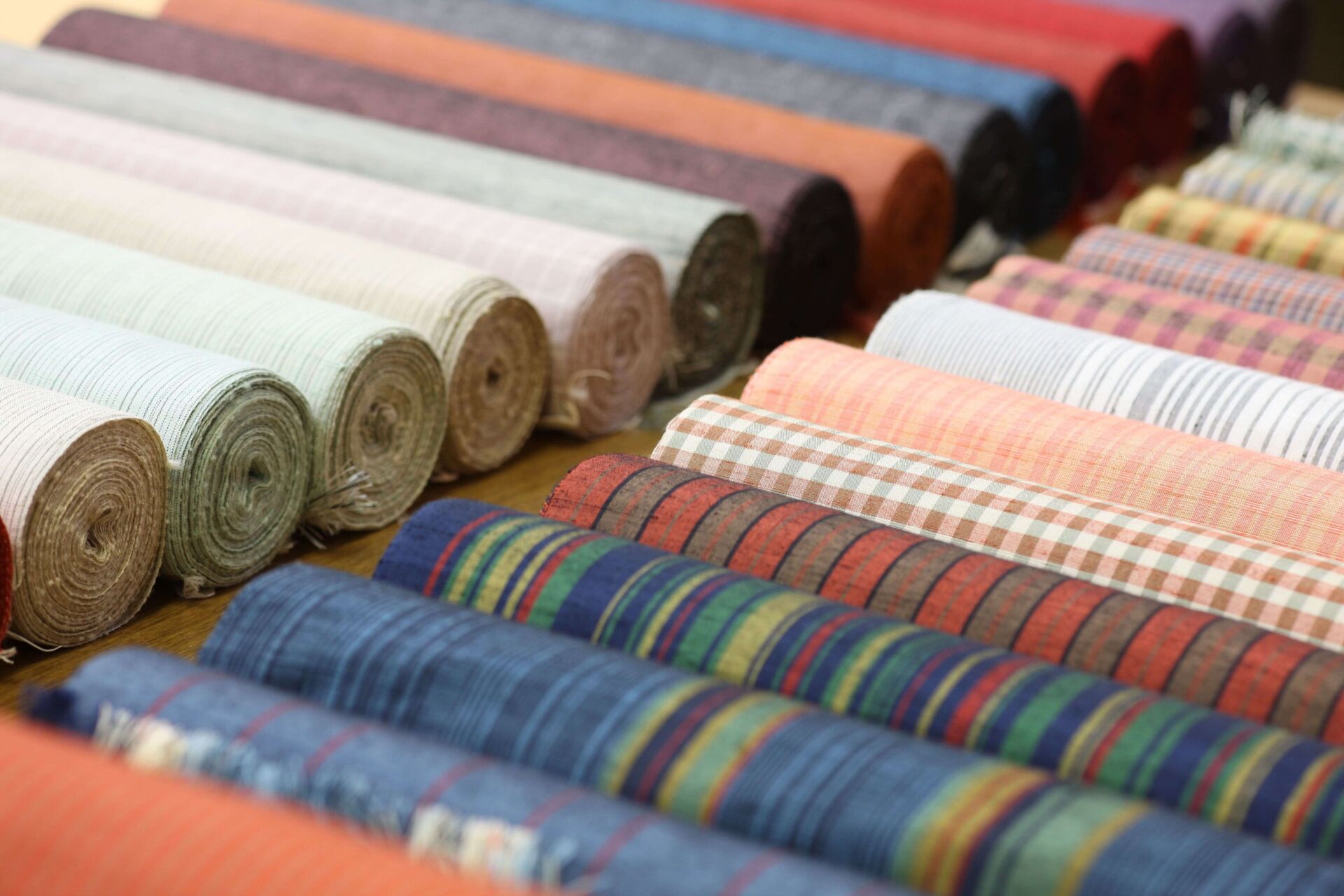
Ueda is home of one of the oldest and most renowned silk-weaving traditions in Japan. Known as ‘Ueda Tsumugi’, local silk production stretches back centuries and is kept alive today but passionate artists and practitioners. The fabric is known for its strength – derived from the weaving of thick gathered strands of silk, called ‘tsumugi’, with single strands – and distinctive design including chequered patterns of blue and brown.
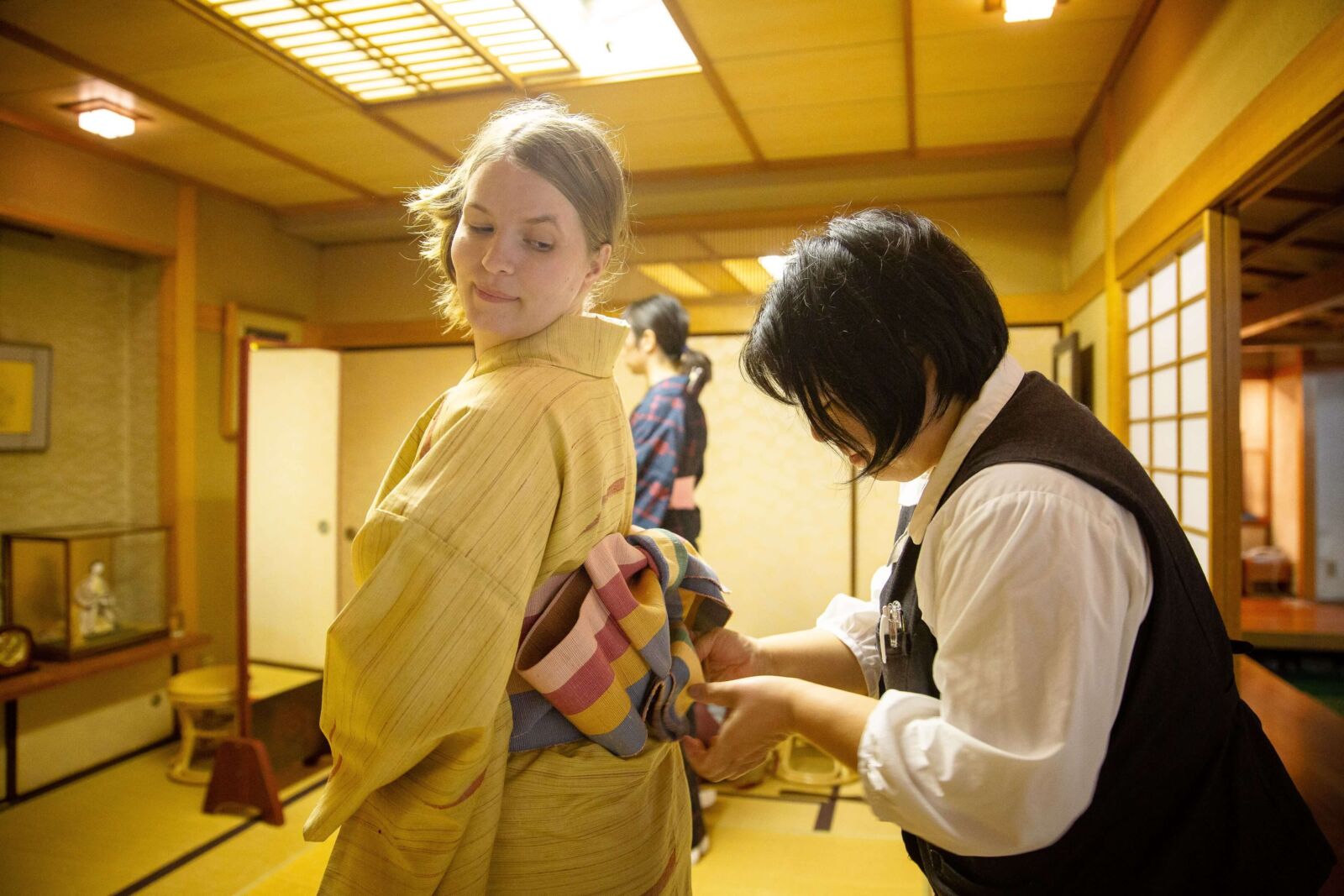
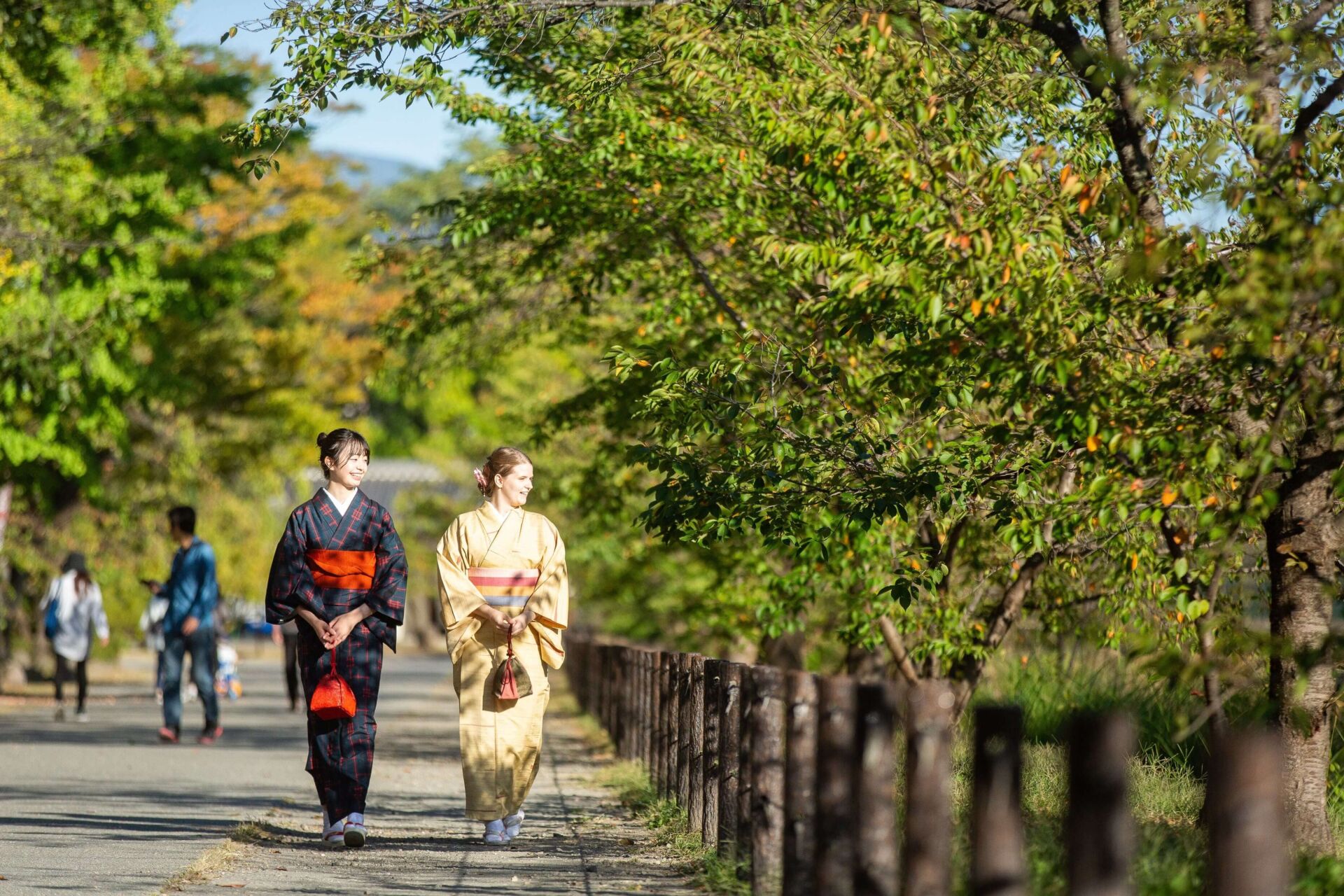
Located under 10 minutes walk from Ueda Station, Yutakaya is a ‘kimono’ store specialising in beautiful pieces created using Ueda Tsumugi. Both men’s and women’s kimono are available for rent, taking around 30 minutes for the stores attendants to have you dress. You can select the kimono you like best from a wide range of patterns before exploring the town in these most traditional and beautiful of garments.
5 / IKUSHIMATARUSHIMA SHRINE / all year round
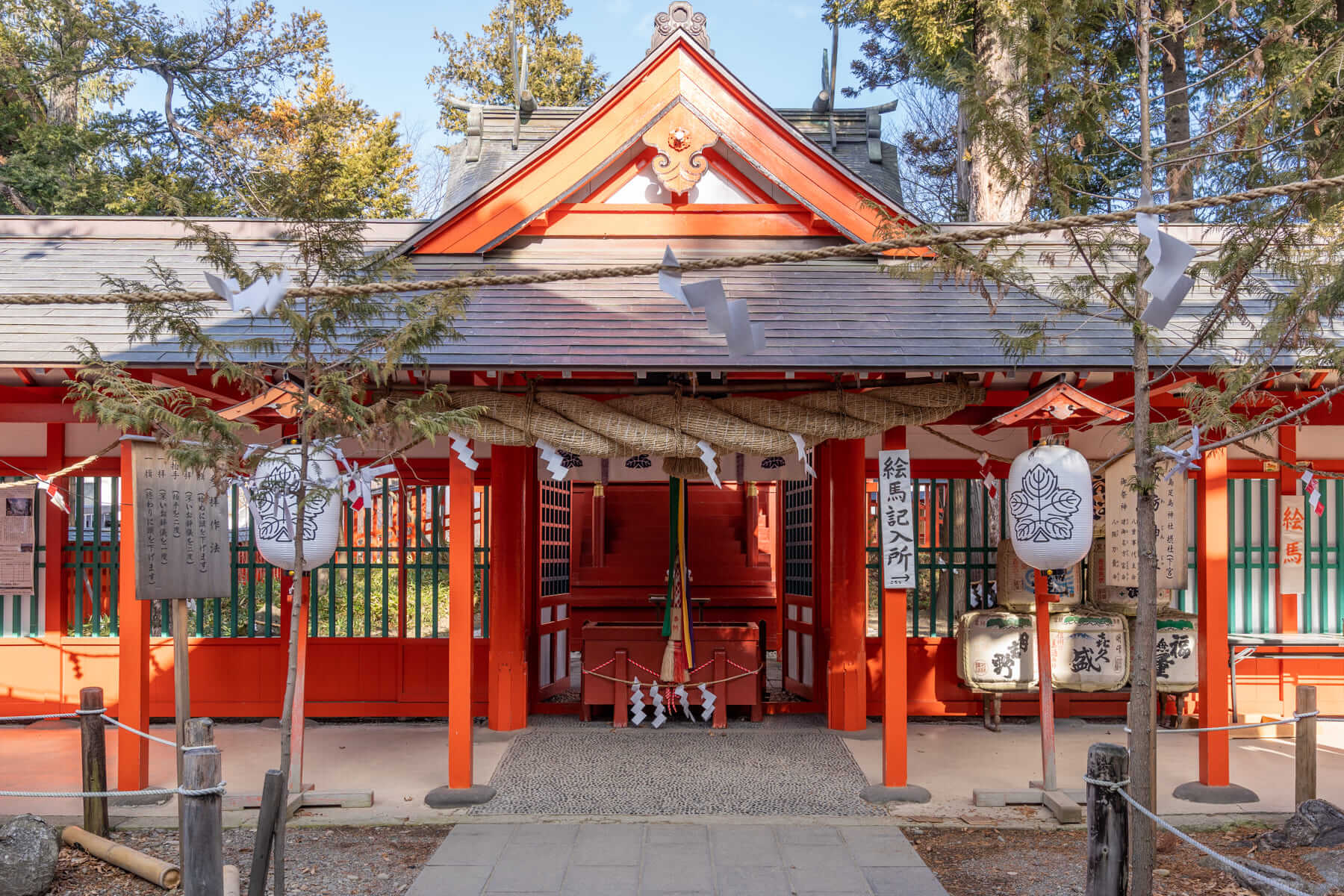
One of the oldest Shinto shrines in Nagano, Ikushimatarushima is one of Ueda’s most important cultural attractions. The exact origins and date of founding of the shrine are unknown however what is known is that Ikushimatarushima houses the powerful ‘kami’ (deities) ‘Ikushima Okami’ – who gifts the power of life to all living beings – and ‘Tarushima Okami’ – who gives satisfaction to all living beings and has a long history of patronage by the Imperial Family and warlords including the local Sanada clan. The main shrine that stands today dates from the mid-20th century but in-keeping with Japanese traditions, it is revered for its ancient origins and for what is houses and represents. The shrine hosts a busy calendar of events including New Year’s celebrations followed by a spring festival on April 18/19, the annual ‘Gion’ Festival on the last Sunday of July along with a Harvest Thanksgiving Festival on November 23. In addition, the important ritual festivals of ‘Mikoro Matsuri’ – held on the third night of November every year – and ‘Mikashira Matsuri’ – held in mid-April but only every seven years – are well-worth experiencing should the timing of your visit be so fortunate!
6 / CHERRY BLOSSOMS & AUTUMN LEAVES / April & October to November
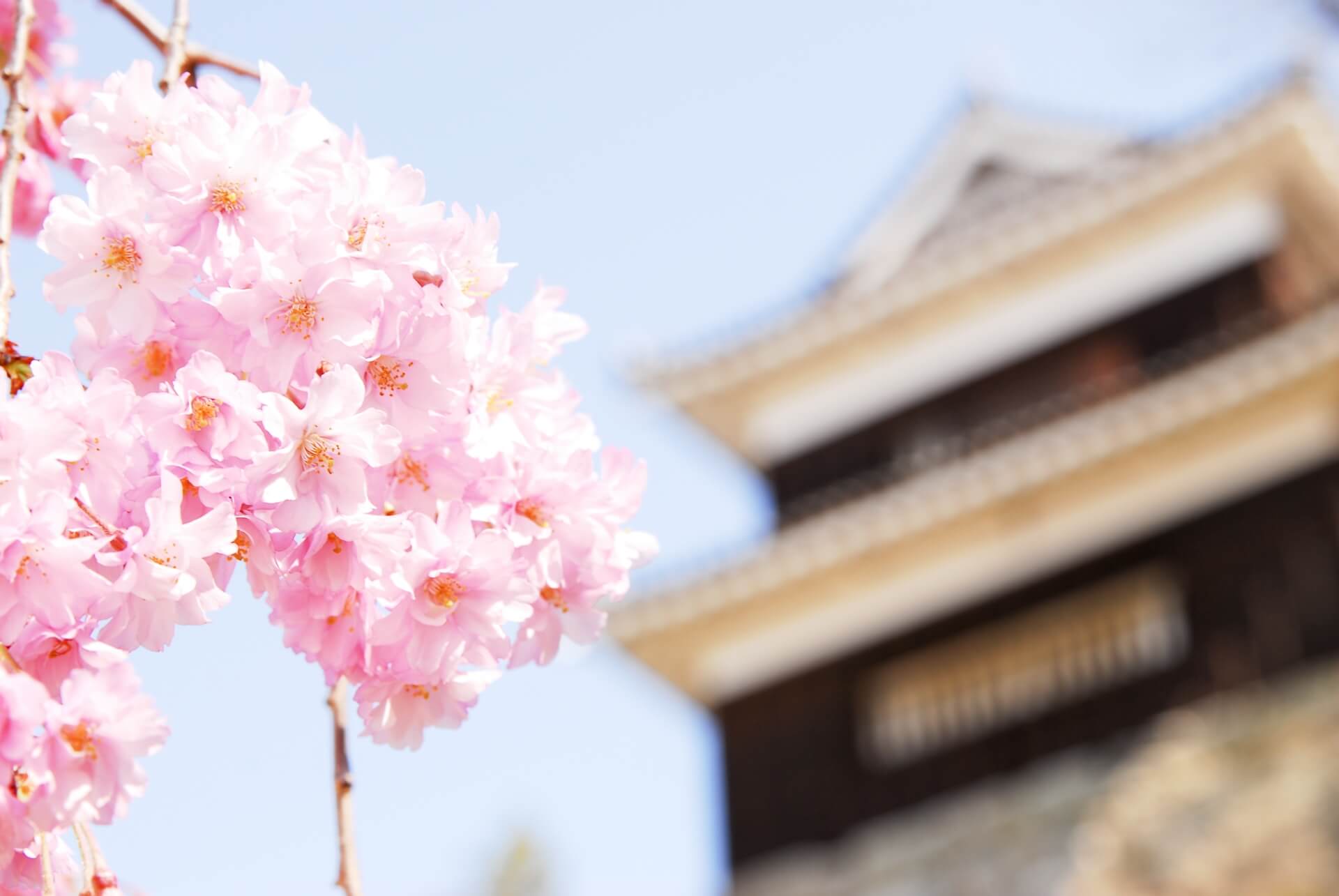
As famous as Japan is for its temples, it is arguably even more famous for the beautiful cherry blossoms of spring. Known as ‘sakura’ in Japan, the blossoms typically bloom in Ueda in the first week of April but can be as early as the last week of March. Ueda Castle Park is without question the most famous and popular blossom-viewing spot in the city with hundreds of cherry trees dotted across the expansive area. In early to mid-April, the park plays host to the ‘Ueda Castle Sen-Bon Sakura Festival’ – a hugely popular festival which draws visitors from all over Japan. Translating as the ‘1000 Cherry Trees’ festival, you get a sense of just what to expect, countless spectacular trees in bloom spread across the park, with food and drink vendors lining the walking paths. This indeed is Japan and Ueda at their best.
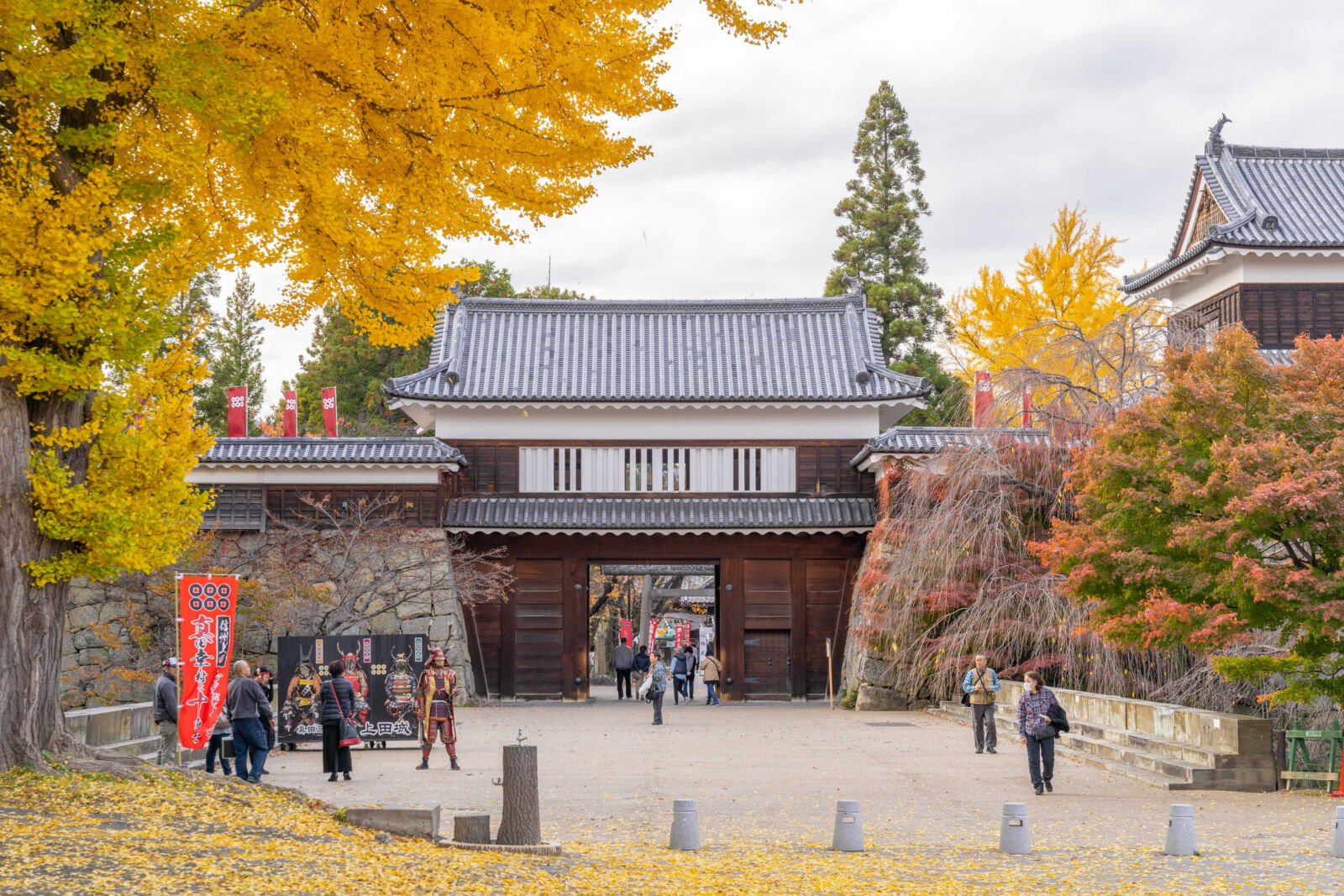
Through October and November, the park and Ueda are just as beautiful as the autumn leaves frame the world in striking shades of red, yellow, orange and brown. You’ll encounter spectacular trees through Ueda and Bessho Onsen – see below for details - but again, Ueda Castle Park is considered the best spot in town with its numerous trees including its deep red ‘momiji’ and yellow gingko trees turning-on a spectacular display that can be enjoyed during the ‘Autumn Leaves Festival’ each November.
7 / BESSHO LINE INC. BESSHO ONSEN STATION / all year round
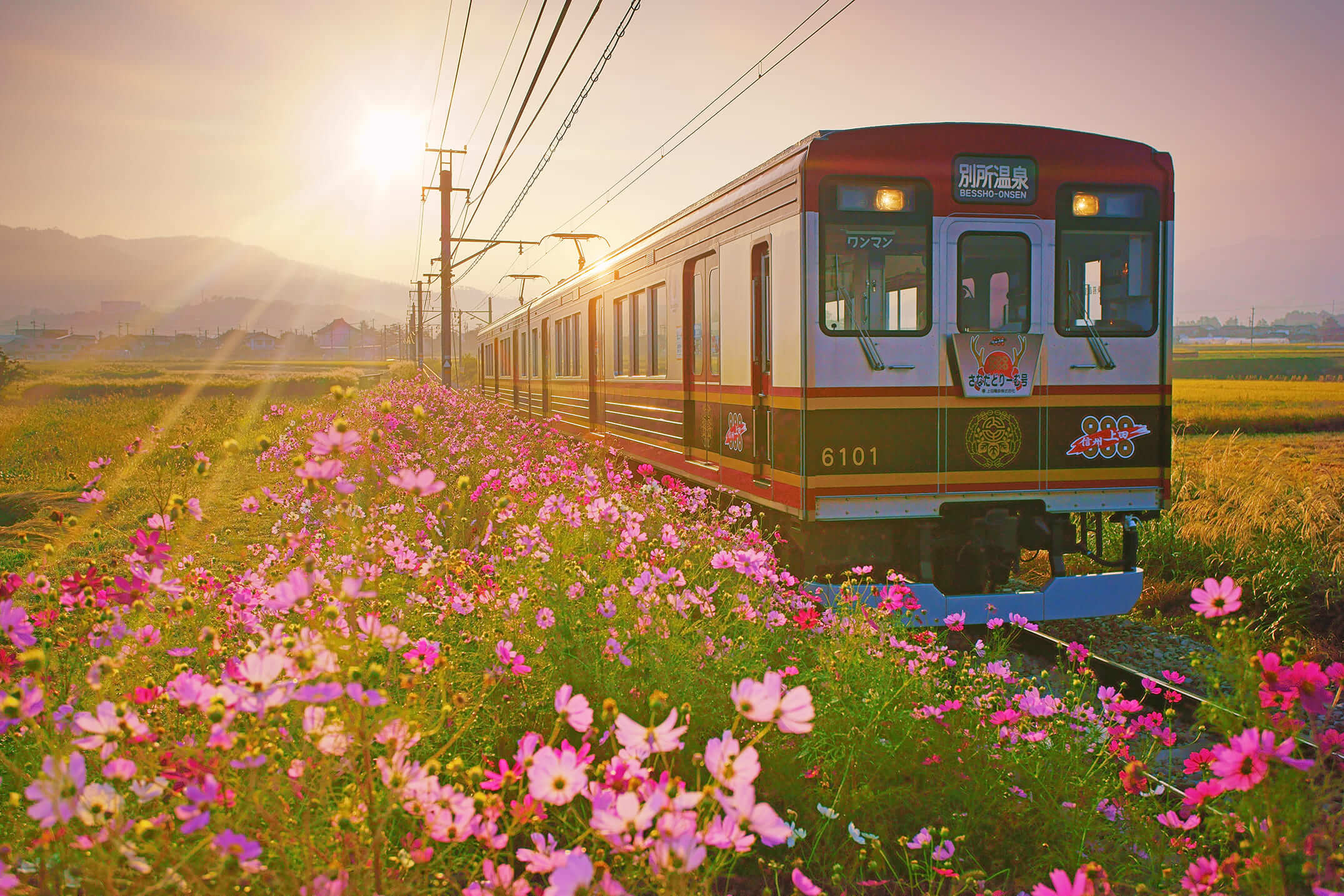
Running from Ueda Station, the single track Bessho Line runs a short 12km to Bessho Onsen. Serviced by a two-carriage train, the line carries passengers through the rural beauty of the surrounding countryside framed by the scenic Shiodadaira Mountains. Riding the decidedly local and quaint train line transports you as much through time as it does space, as you move toward Ueda’s legendary ‘onsen’ (hot spring) town and into a world of nostalgic charm. Featured in the popular anime film ‘Summer Wars’, the Bessho Line is a popular experience for many with its terminus of Bessho Onsen Station being an attraction in its own right. Built in the mid-20th century, the timber and stone station is particularly photogenic.
8 / BESSHO ONSEN & THE HIDDEN HOT SPRINGS OF KAKEYU & KAKUMA / all year round
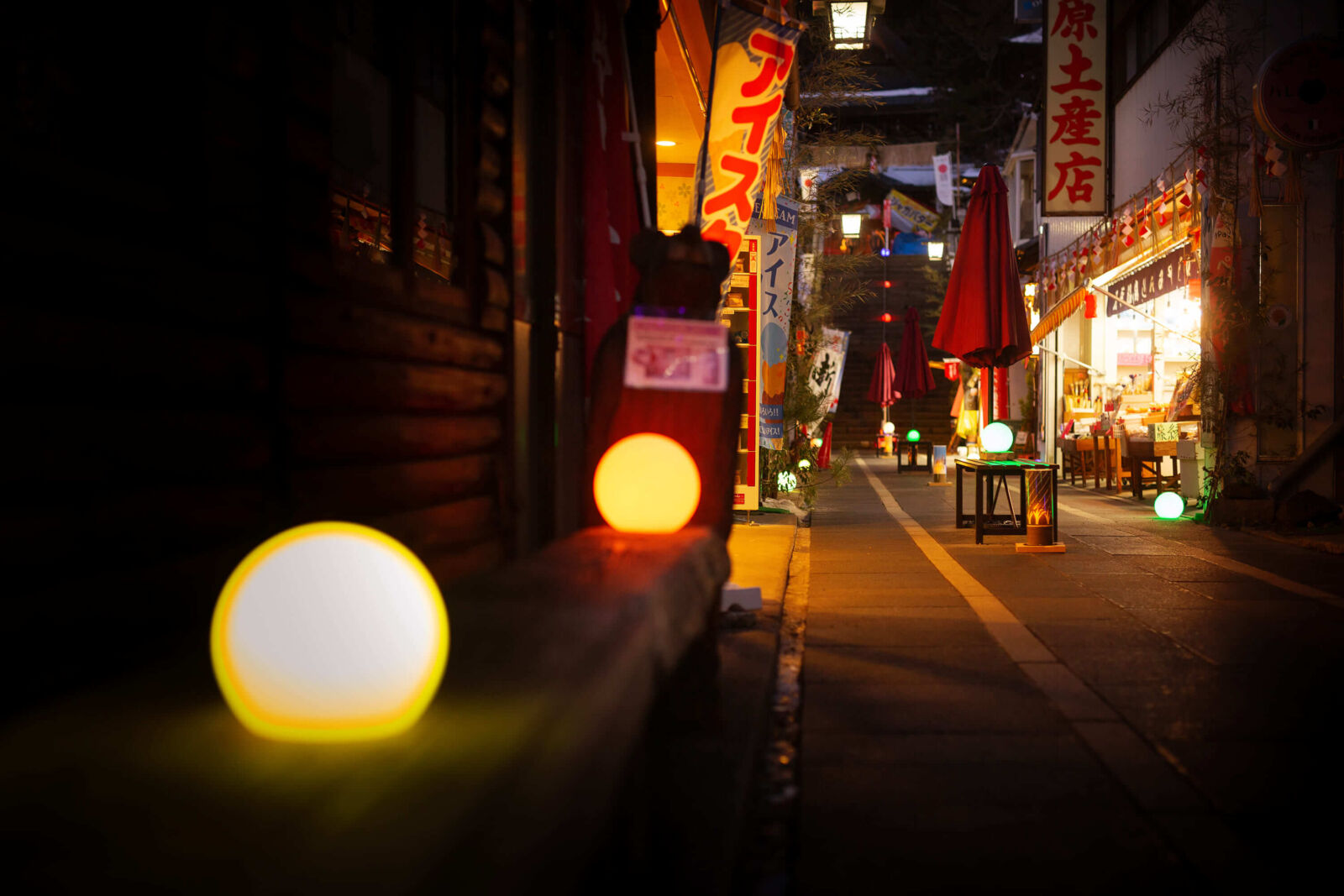
With a history stretching back 1400 years, Bessho Onsen lays claim to being the oldest hot spring town in Nagano. During the Kamakura Period (1185-1333), Bessho was an important administrative, educational, and religious centre and today this day retains several interesting temples including Anrakuji – see below for details. The town’s sulphuric water feeds many ‘ryokan’ (traditional guesthouses) and multiple public baths and foot spas.
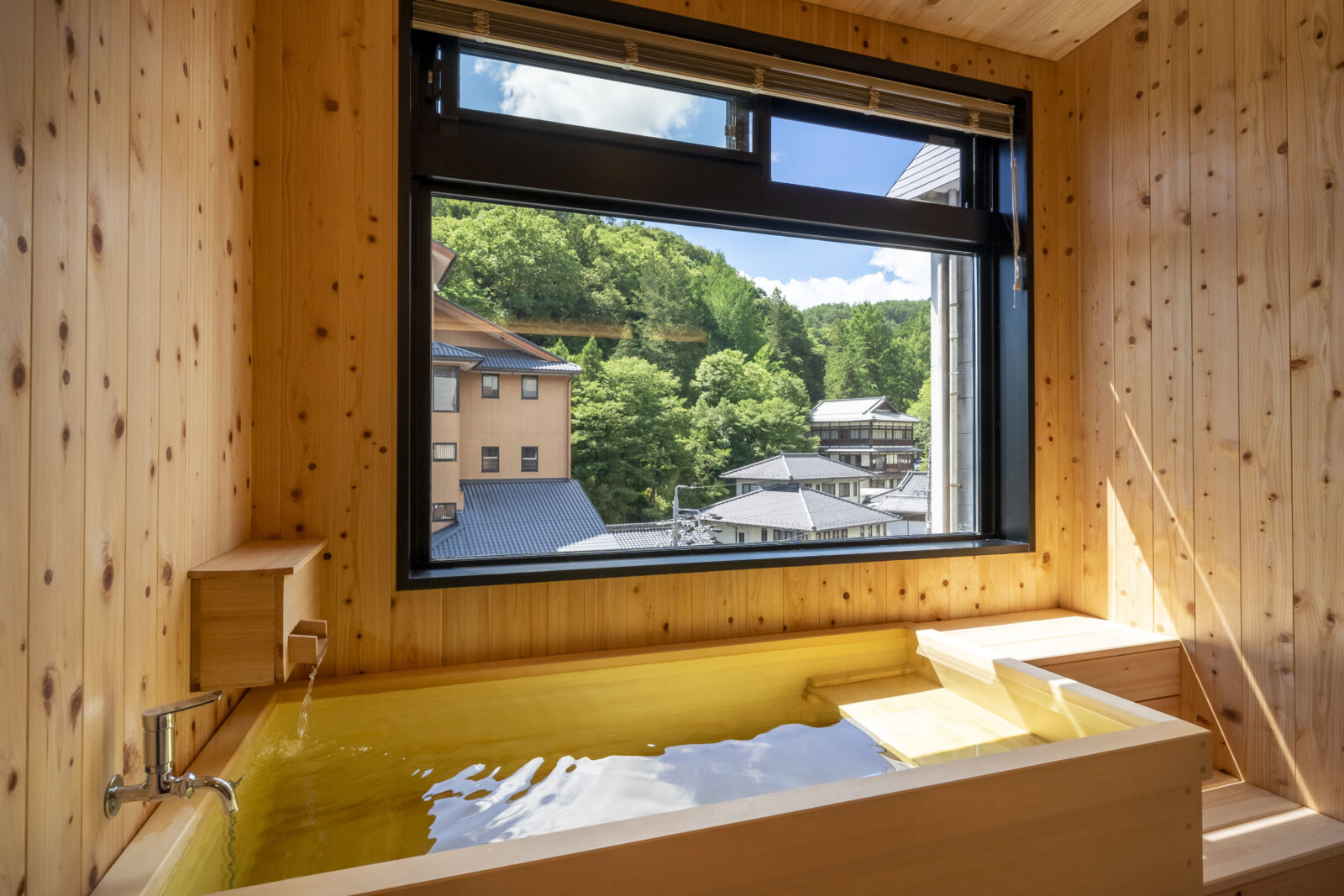
Bessho Onsen is a small town that can be leisurely explored on-foot with its main temples located along the forested hills that border the central area. Like many traditional hot spring towns, the true charm of Bessho lies in walking its streets and laneways to discover the hidden charms of the past the sit alongside modern conveniences and buildings. This is a destination where you take it slow – that’s the pace of life in Bessho – with the emphasis on soaking your soul in its famous baths. Highly-photogenic and always charming, spending a day or night in Bessho Onsen offers one of Nagano’s best hot spring experiences.
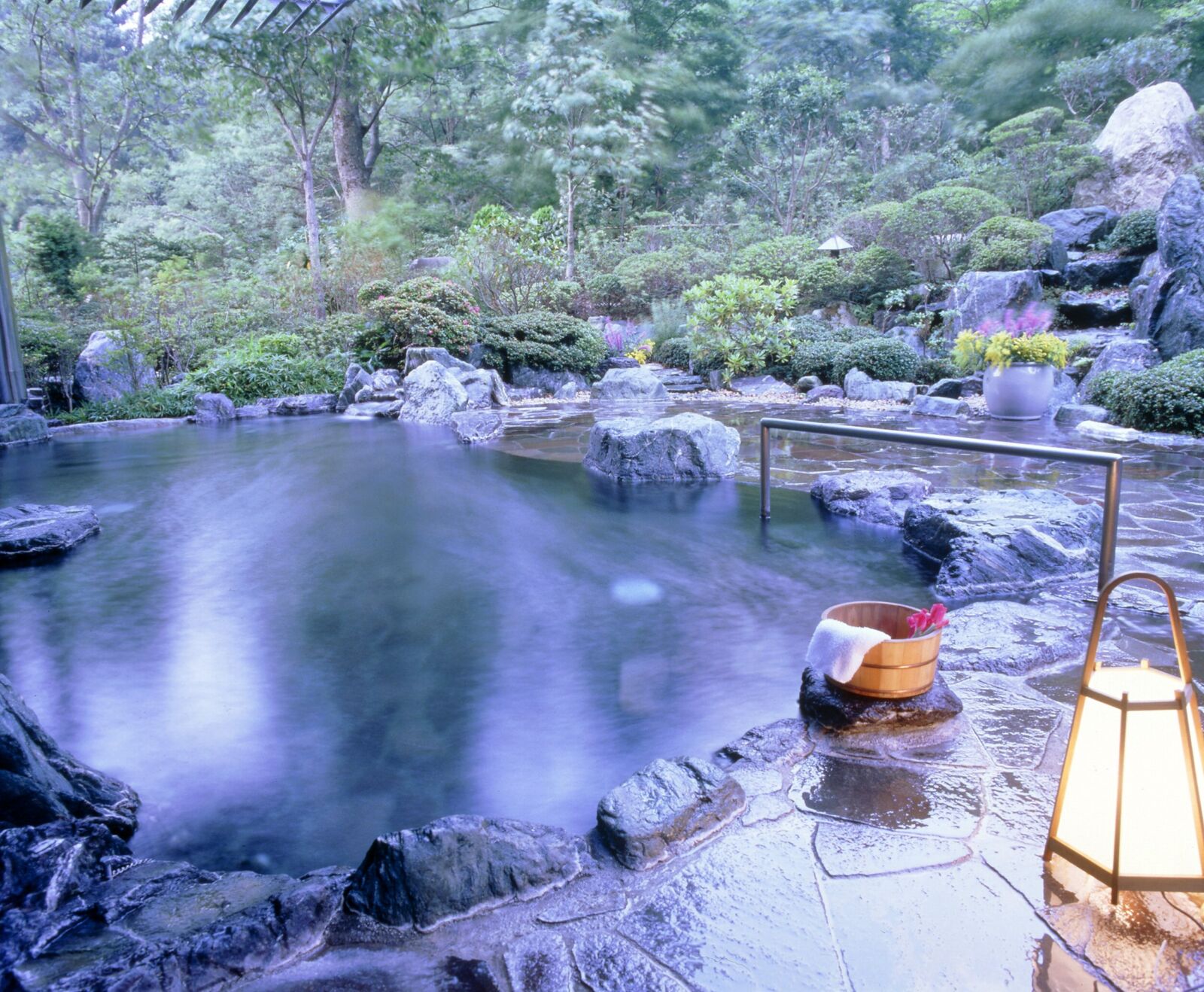
Located around 50 minutes by taxi from Ueda Station, Kakeyu Onsen takes a little more time to get to but is well worth the effort. Kakeyu is home to multiple hotels and guesthouses including their own hot springs while in winter, the town hosts an annual lantern festival from December to January. Nestled in beautiful surrounds approximately halfway between Ueda and Matsumoto, Kakeyu Onsen is something of an undiscovered gem and ideally-suited to travellers who are renting a car and driving themselves. Closer to Ueda – only 30 minutes drive - but in all other ways even more hidden, Kakuma Onsen lies within the beautiful Kakuma Valley and offers only one accommodation option – Iwayakan. This high-end traditional ‘ryokan’ (guesthouse) is ideally-suited to any visitor wanting a true escape into the Japanese heartland to enjoy all the trimmings and comforts of a hot spring hotel set within a truly beautiful landscape.
9 / TEMPLES OF BESSHO ONSEN INC. ANRAKU-JI / all year round
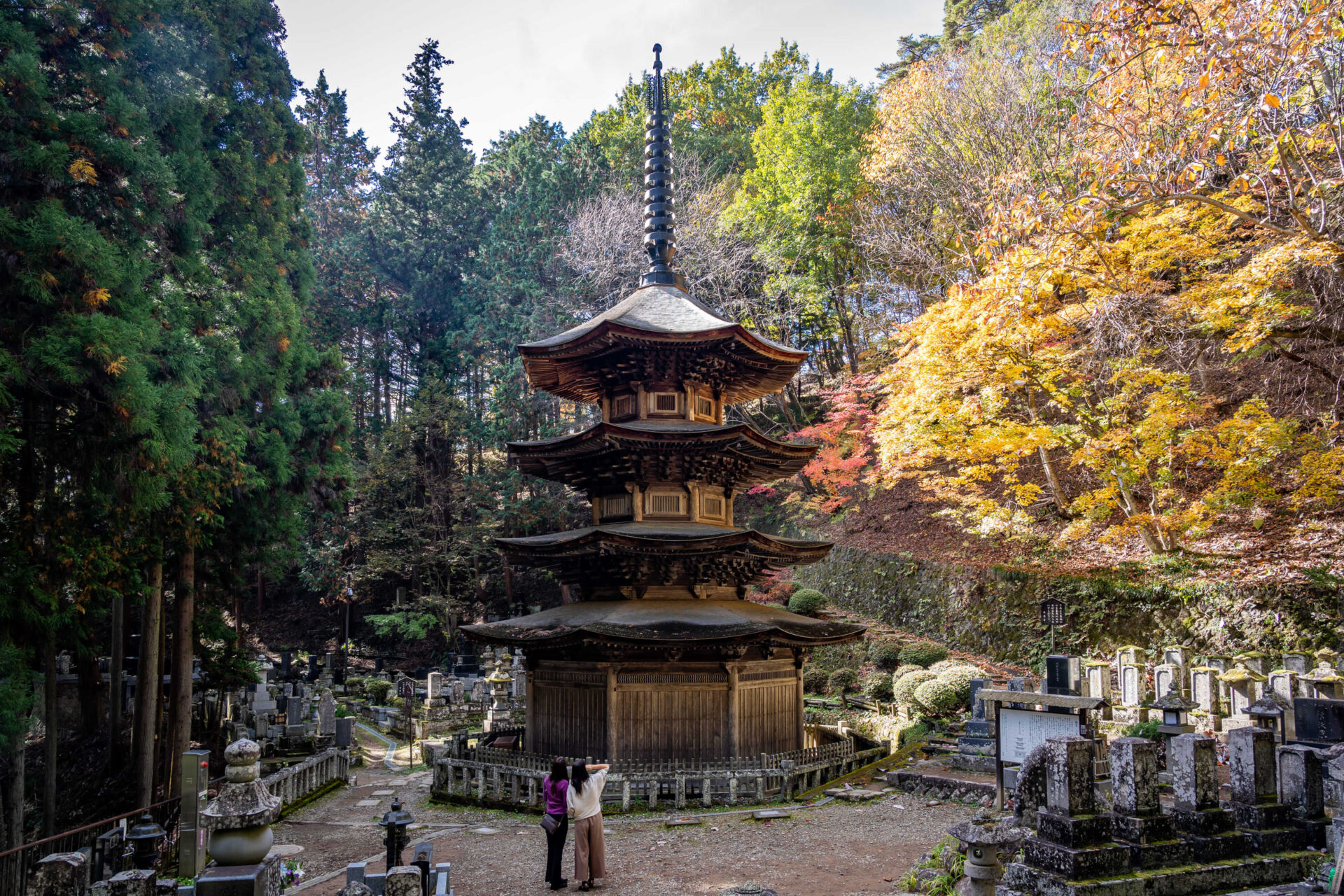
Bessho Onsen’s profile as an important administrative, cultural and religious centre during the Kamakaru Period is attested to by the preservation of several notable temples – all of which can be accessed following a leisurely walking route. Anraku-ji Temple is the most celebrated of the temples, famous of its three-storied octagonal pagoda – the only surviving eight-sided pagoda in Japan and a registered National Treasure. Located behind the temple’s main hall, the pagoda is believed to date to the 13th century in a style consistent with that prevalent under the Chinese Song Dynasty (960-1279). Anraku-ji is open daily from 08:00 to 17:00 (or until 16:00 from Nov. to Feb.). Admission costs JPY300.
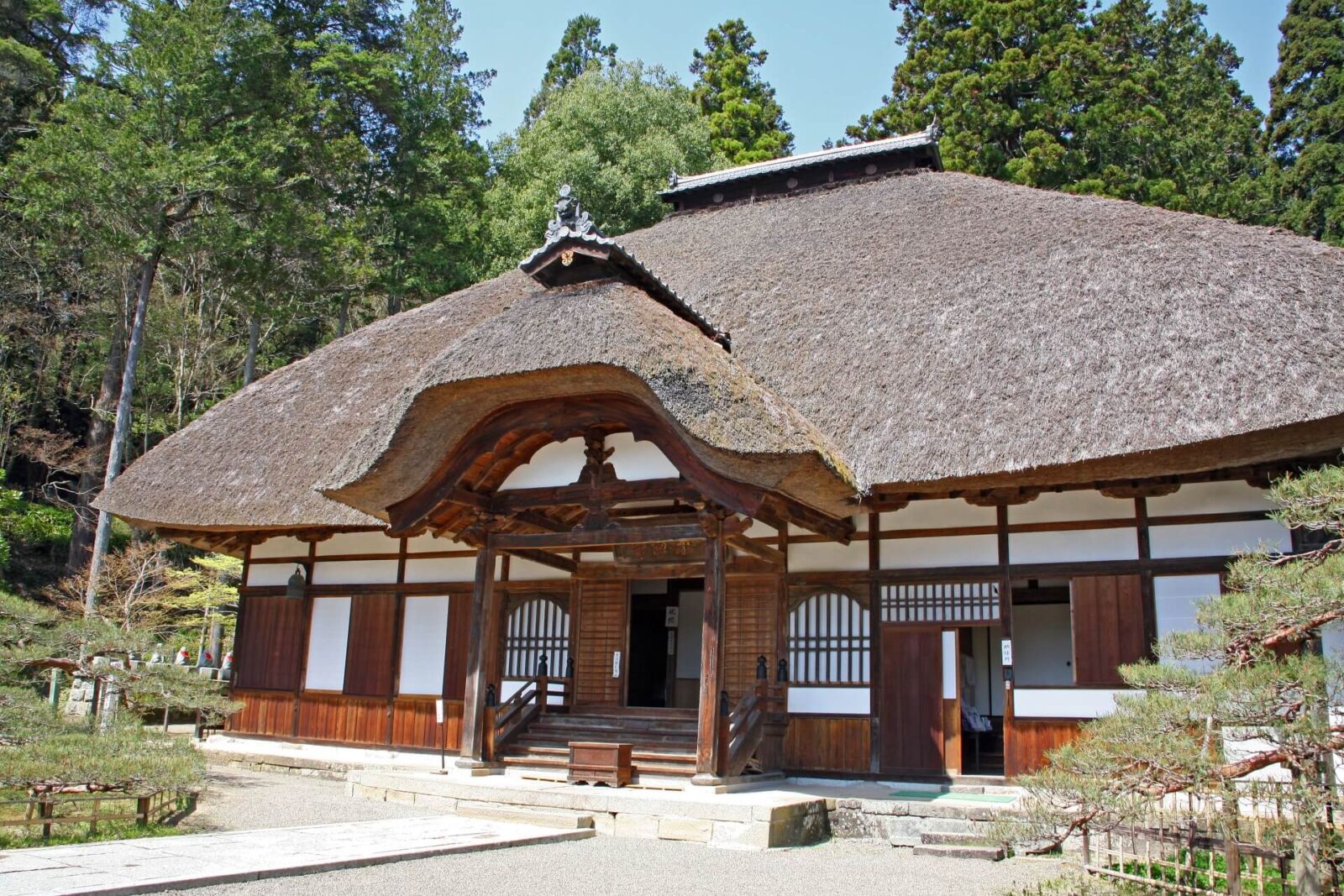
Only 5 minutes walk from Anraku-ji, Joraku-ji is a beautiful thatch-roofed temple first established in the 9th century. It is one of the oldest temples belonging the Tendai sect – a historic and important Buddhist sect in Japan – in Nagano and particularly photogenic given the continued preservation of its thatched roof. Joraku-ji includes a small art museum with small artworks created by Japan’s most celebrated artist, Hokusai. The temple is open daily from 09:00 to 17:00 though the museum is closed from December 25 to January 25. Admission to the temple costs JPY100 and JPY500 for the museum.
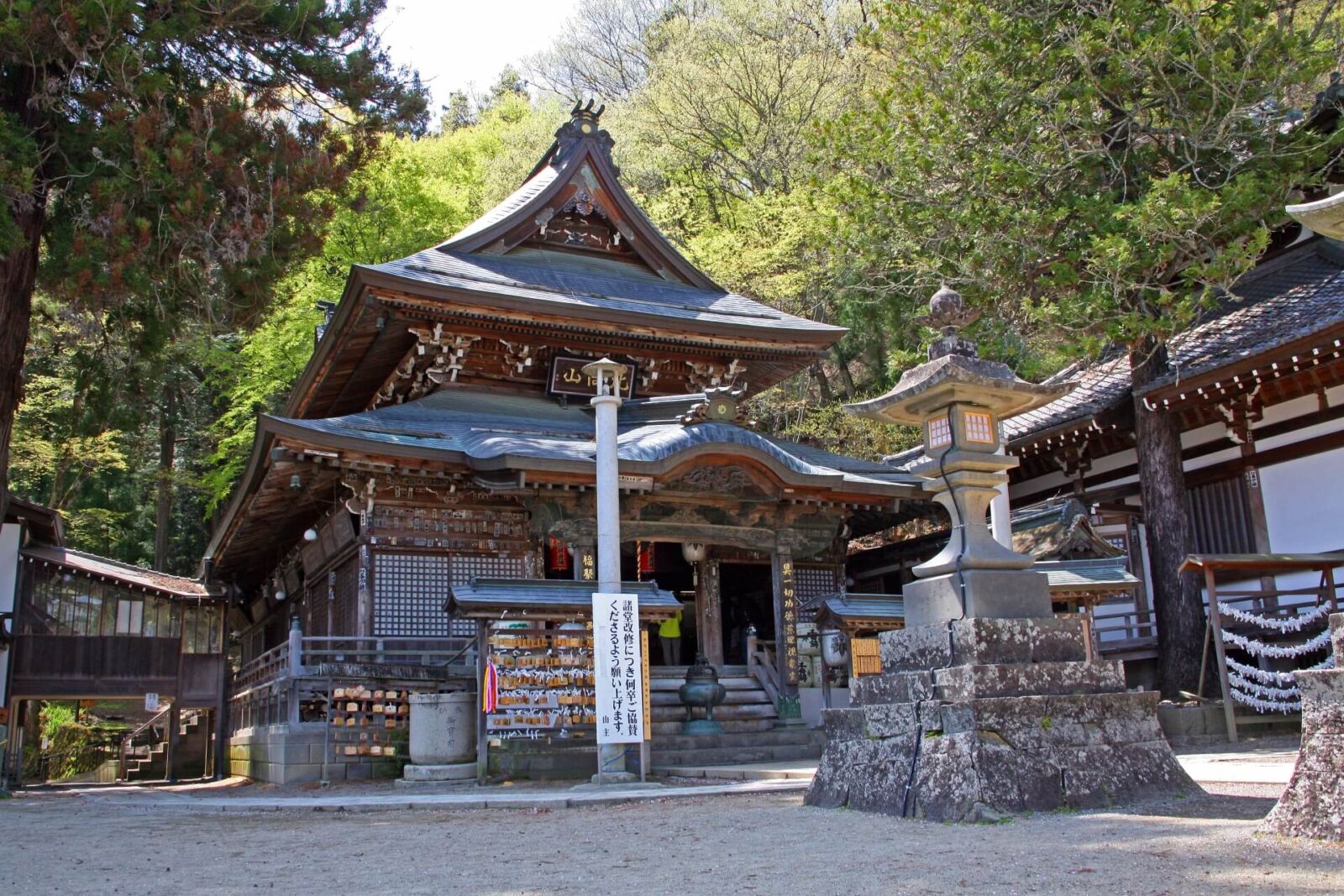
Kitamuki Kannon Temple is also located around 5 minutes walk from Anraku-ji; a temple that unusually faces north – toward Nagano’s Zenko-ji Temple - rather than the usual alignment to the south. The temple is dedicated to Kannon, Goddess of Mercy, and is another photogenic spot worth investigating while in Bessho Onsen. Kitamuki is open daily from 06:00 to 17:00 (opening and closing an hour earlier from Oct. to Apr.) and admission is free.
10 / ZENSAN-JI TEMPLE & 'KURUMI O-HAGI' / all year round
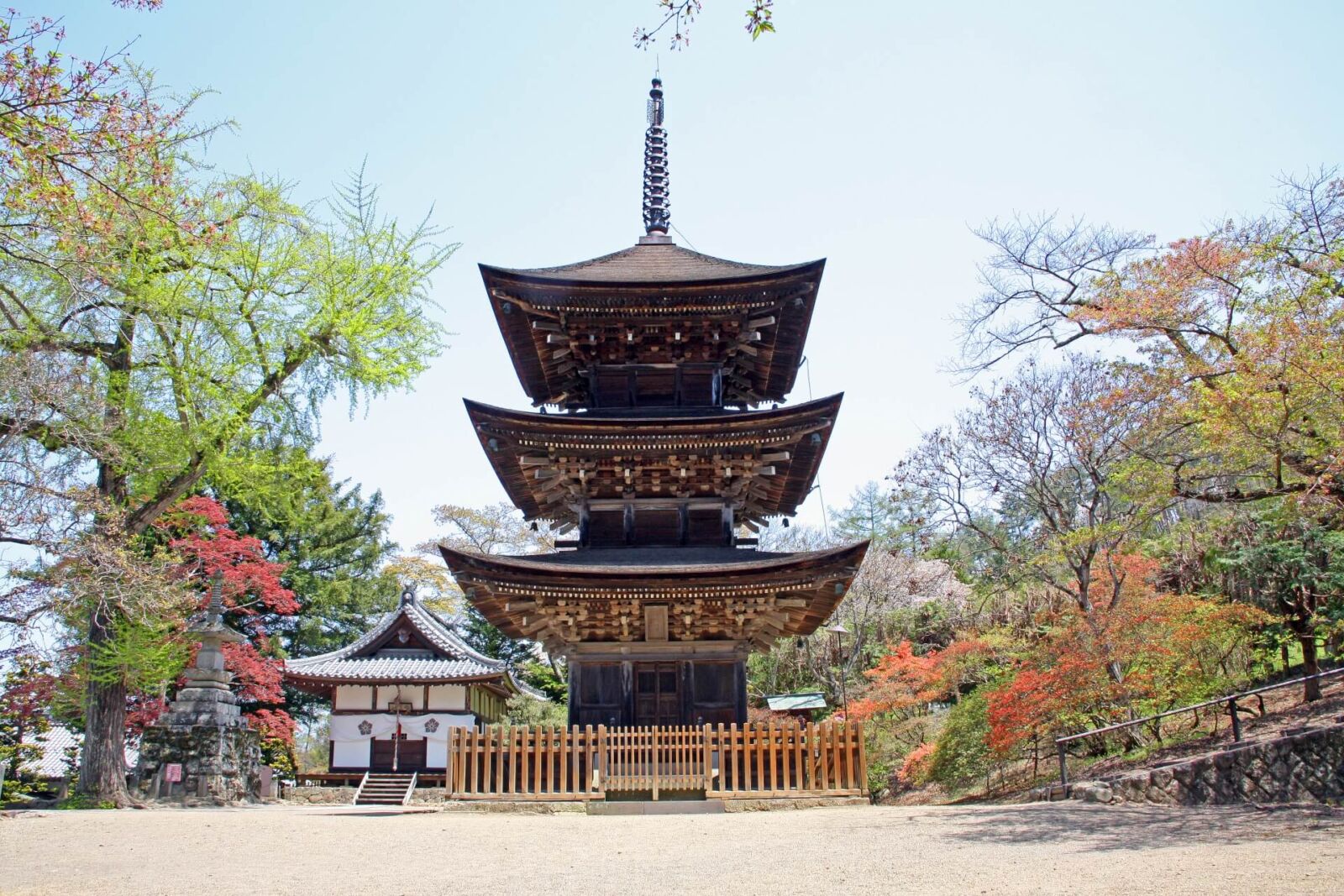
Part of Bessho Onsen but located around 10 minutes by taxi from centre of town, Zensan-ji is historically important temple founded in the early-9th century. Most famously, Zensan-ji is home to three-storey pagoda that dates back to the Muromachi Period (1336-1573) – a registered National Important Cultural Property. The pagoda is said to be unfinished, with the second and third tiers missing balustrades, windows and doors.
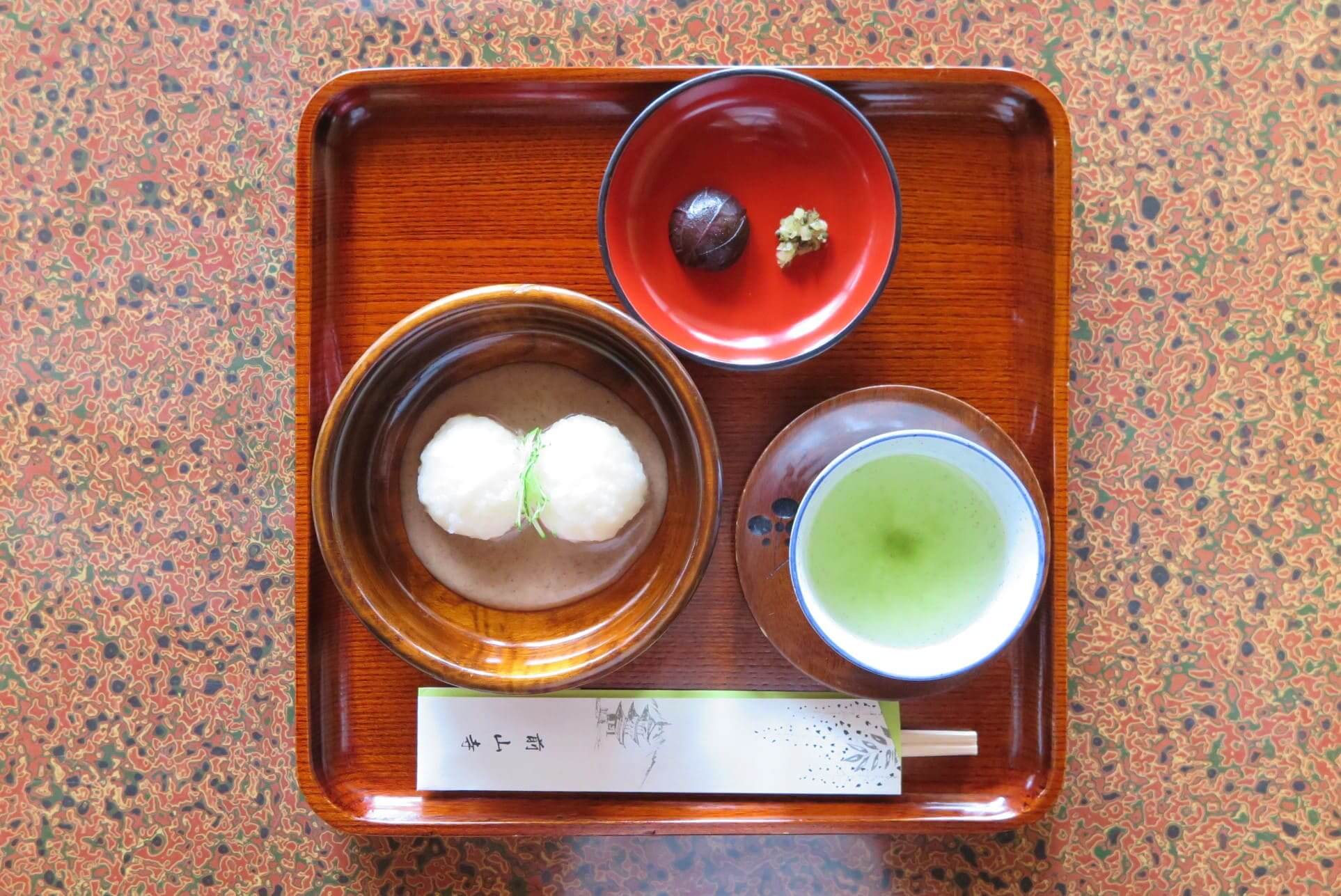
In addition to the famous pagoda, visitors to Zensan-ji can also enjoy its beautiful flower gardens and handmade ‘kurumi o-hagi’ – delicious rice cakes served with ‘onigurumi’ (Devil’s Walnut), ‘mukozuke’ (shiso-wrapped plums) and tea. The temple is open daily from 09:00 to 16:00. Kurumi o-hagi costs JPY900 and is a popular treat meaning you might have to wait awhile to be served.
11 / WINTER ICE LANTERN FESTIVALS / December to February
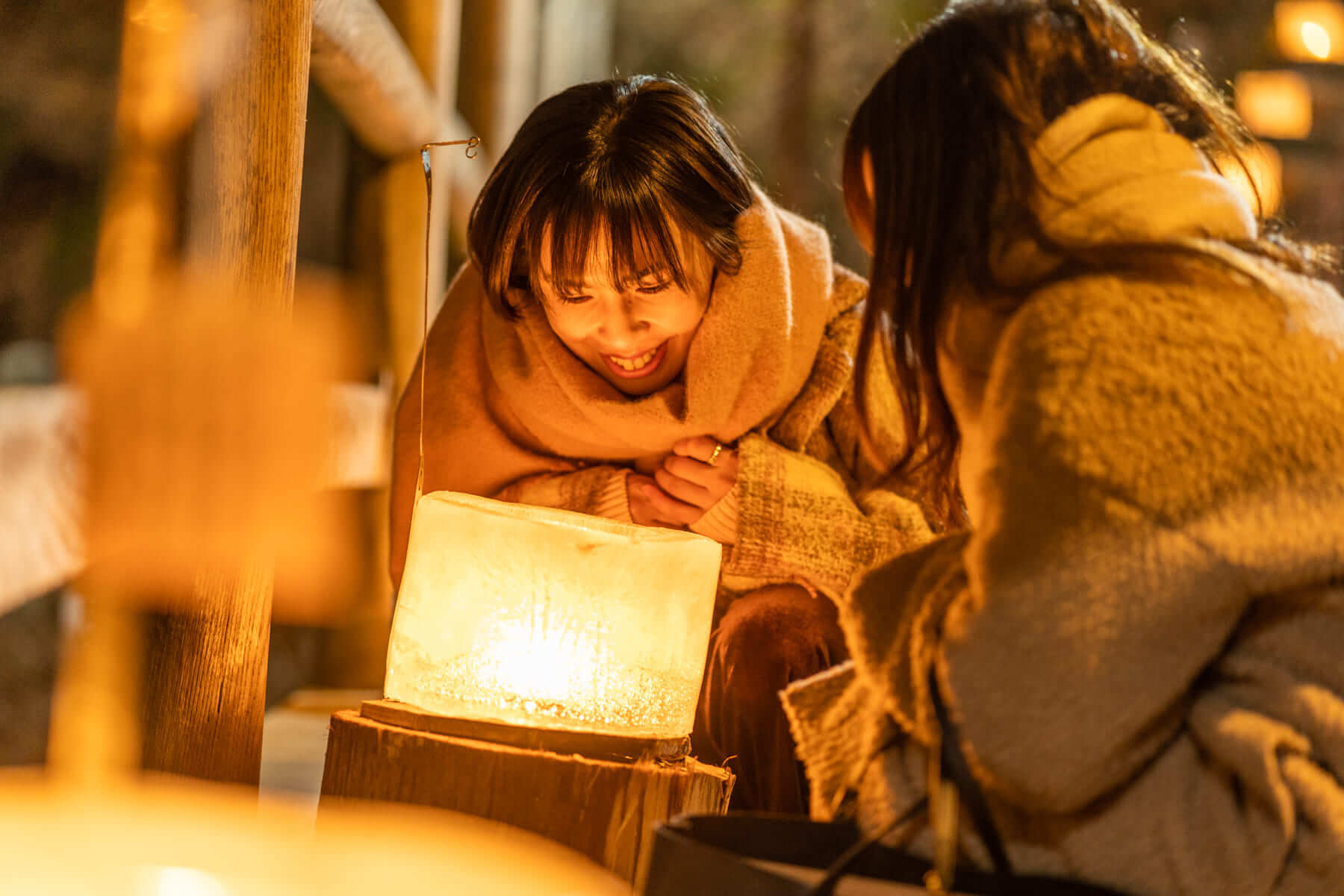
*This even is not being run for the time being.
Visitors heading to Bessho Onsen in winter can enjoy the beauty and tradition of its Ice Lantern Dream Festival. Taking place each year in January and February, festivities begin with January 7th as areas and monuments in Bessho Onsen are lit-up every evening from 16:30 to 21:00, before the main celebration of the Ice Lantern Festival takes place from February 9th to 13th. During that time, the approach to Kitamuki Kannon temple is adorned with lanterns and light balls from 16:30 to 21:00 with the temple’s main hall illuminated from 18:00 to 21:00.
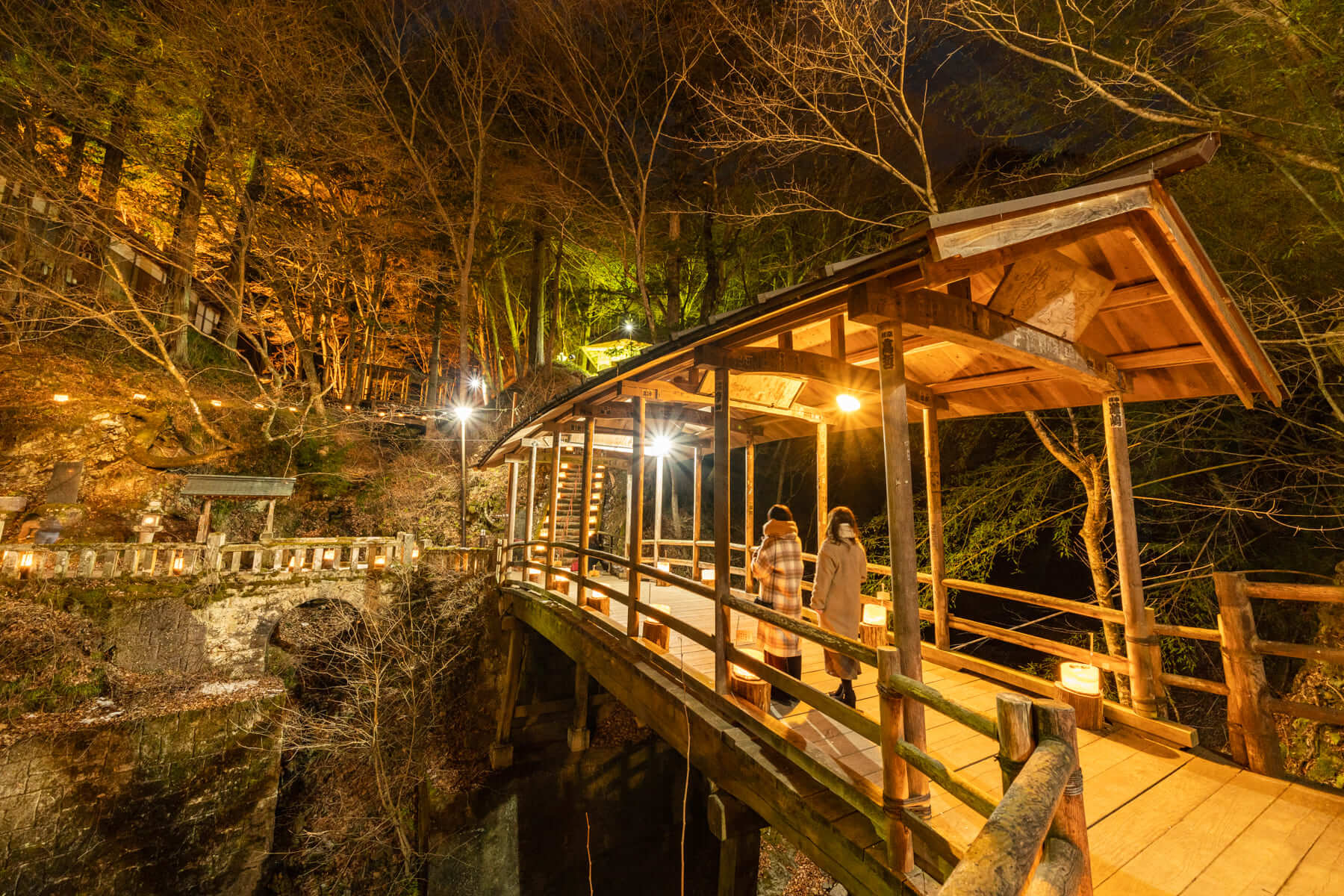
Similarly, Kakeyu Onsen hosts its own lantern festival - 'Koori Dourou Yumekigan' - from December 28th to January 31st, with features including public bathhouses and Gotai Bridge lit by burning lanterns from 16:30 to 21:00. Visitors can also choose to take place in the festival by purchasing and lighting their own lantern should they wish to. Lanterns are available at Kakeyu Onsen Tourist Association for JPY700 and are lit daily at 16:30.
12 / SUGADAIRA KOGEN SNOW RESORT / December to April

Around 60 minutes drive from Ueda Station, Sugadaira Kogen is a favourite ski resort with local residents and Tokyoites but largely unknown to international visitors. The resort sits between 1270 to 1580 metres and offers visitors 175 hectares of terrain and 36 courses. Divided into three areas – Taro, Davos and Pine Beak – Sugadaira doesn’t receive the legendary snowfall of other Nagano resorts including Nozawa Onsen and Hakuba, but thanks to its elevation the snow that it does receive stays in condition giving it a long season. Well-suited to beginners and lower-intermediate skiers and boarders, Sugadaira Kogen Snow Resort is a good option for anyone looking to escape the crowds of Nagano’s more popular ski resorts.
13 / SNOWCAT IN SUGADAIRA / December to April
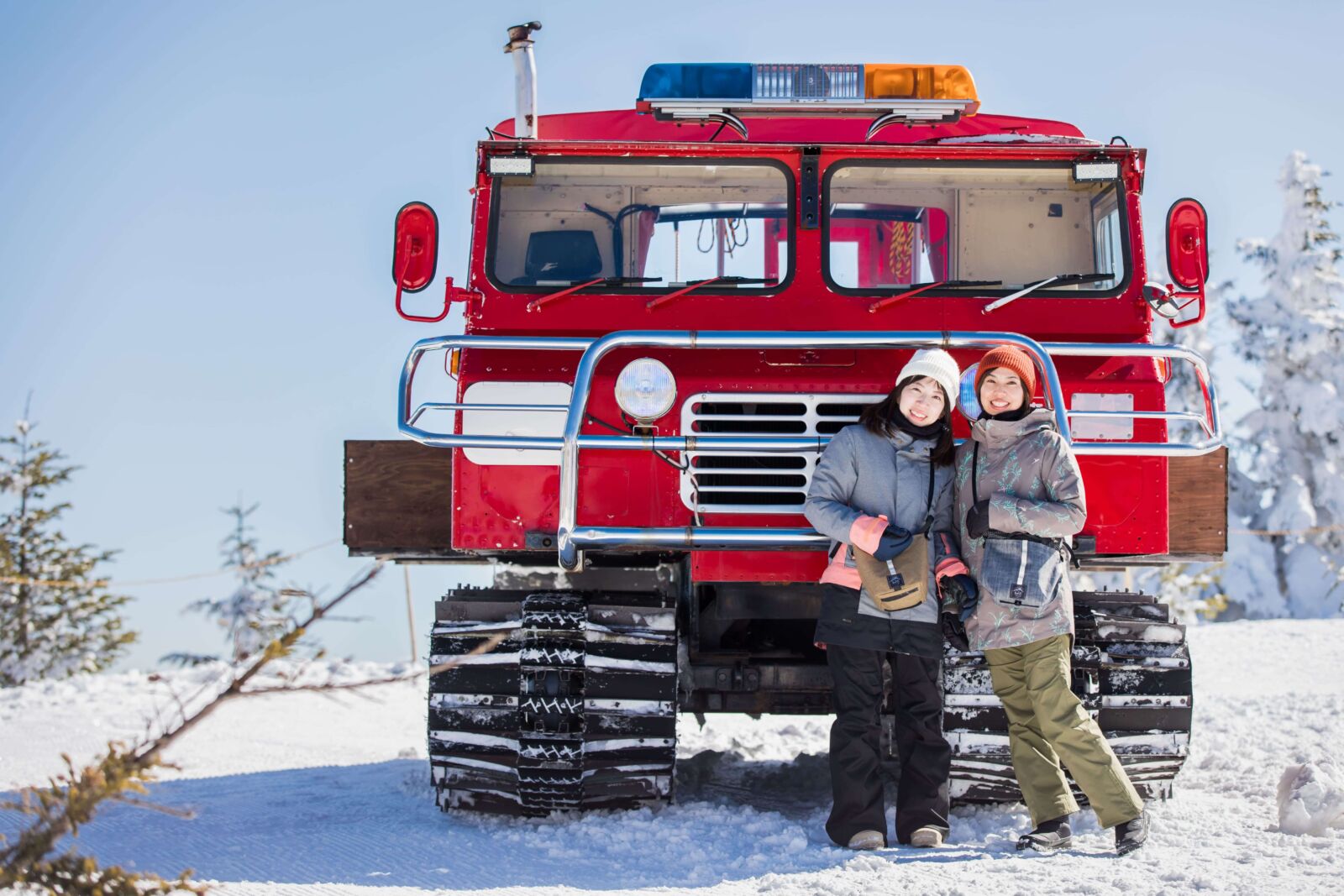
Visitors to Sugadaira can enjoy snowcat tours in the Davos area of the ski resort – a memorable way to ascend above the resort and enter a true winter playground. Starting from 1400 metres, guests first ride a chairlift to 1595 metres above sea level where they board the snowcat for the 25 minute ride toward the summit of Mount Neko. Disembarking at 2170 metres, guests can walk through snow-wrapped trees to the summit from where, at 2206 metres above sea level, you are spoilt with a panoramic view of the surrounding mountain chains. On a clear day you can see up 30 to Japan’s ‘100 Famous Mountains’ before re-boarding the snowcat for the return journey or should you wish to, to ski or snowboard back into the resort along the snowcat track.
14 / UEDA CITY ‘SANTO MUSE’ MUSEUM / all year round
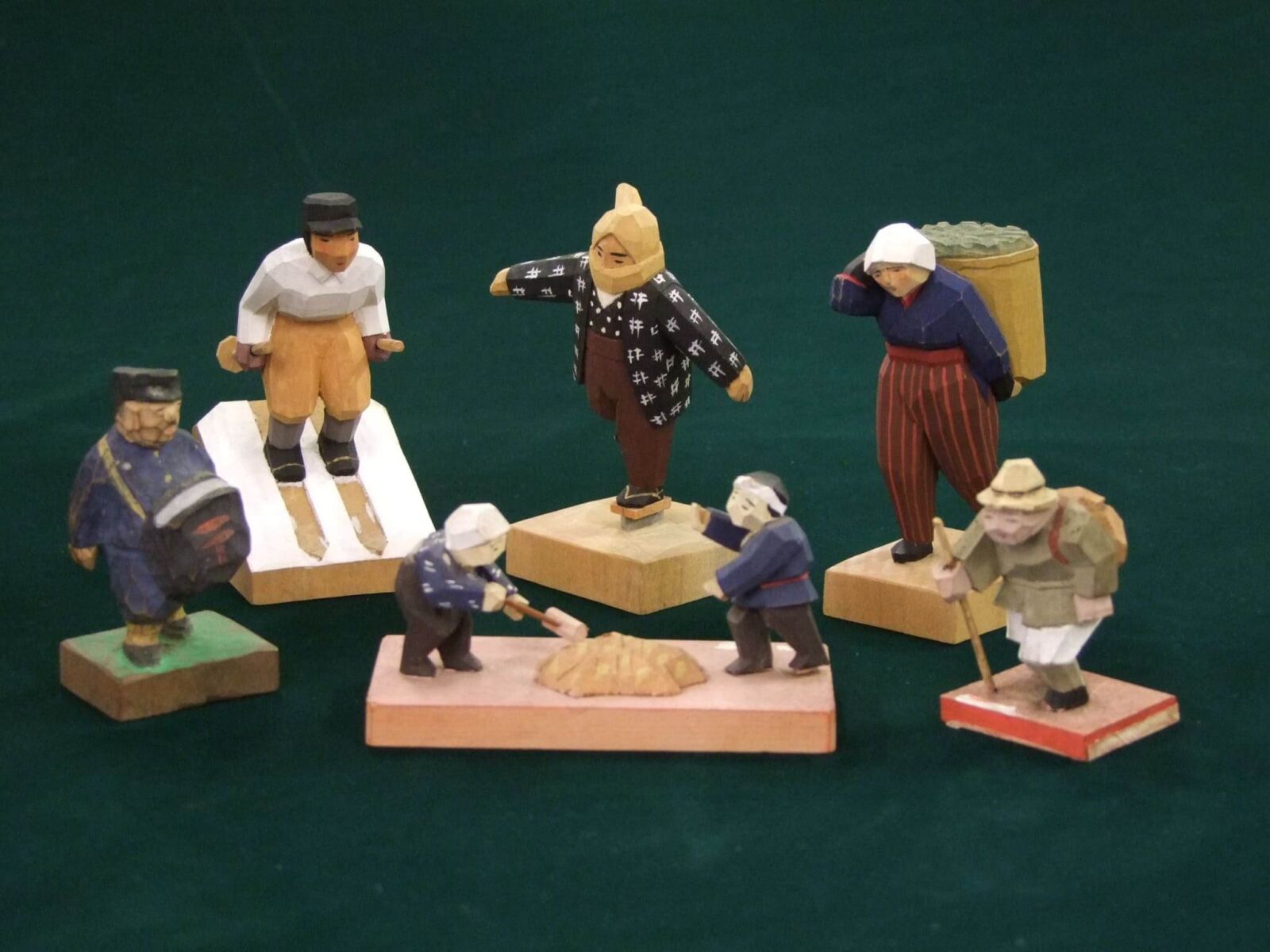
Ueda City ‘Santo Muse’ Museum is a multipurpose institution dedicated to promoting the arts in the city with a focus on local artists including painter Yamamoto Kanae, sculptor Ishii Tsuruzo and photographer Shigeta Harry K., among many others. The museum includes exhibition, events spaces and a cafe. Visitors to the museum should make sure to head to the museum giftshop where traditional Koppa Ningyo – palm-sized carved wooden dolls – are sold. Beautifully-designed and cherished by local residents, Koppa Ningyo make a distinctive and charming keepsake for any visit to Ueda. As another local artist Yamamoto Tadashi expressed, 'What you feel directly is precious'. The residents of Ueda hope you feel a strong affection for their beloved dolls. The museum is open daily except Tuesdays (or the following day should Tuesday be a public holiday) and from Dec.29 to Jan.1, from 09:00 to 19:00 (with last entry at 16:30). Admission to the permanent collection costs JPY300 for adults and from JPY300 to JPY200 for school students. The price for admission to special exhibitions varies.
15 / UEDA EIGEKI & FUKUROMACHI / all year round
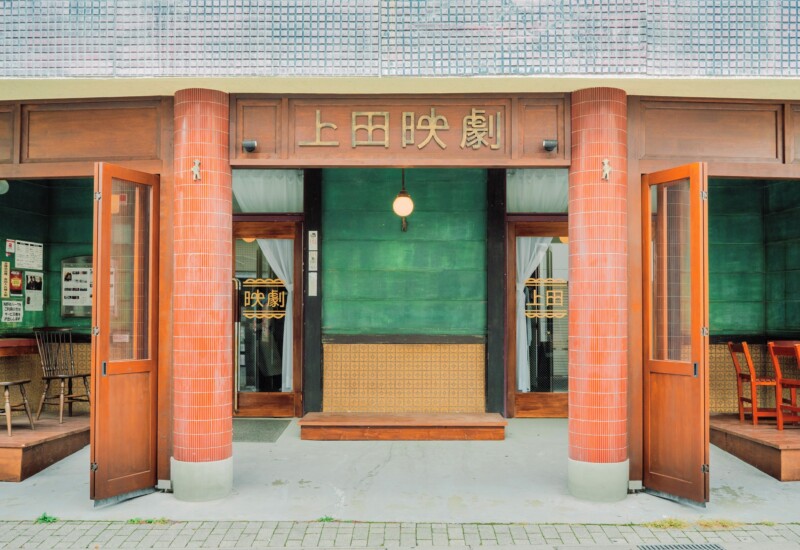
Ueda’s growing reputation as nostalgic destination of retro gems is encapsulated by its small Fukuromachi precinct; an aged and fading yet intriguing pocket of side streets that retains much of its Showa Period (1926-1989) charm. Only a couple of minutes walk from Ueda Station, Fukuromachi is home to many restaurants making it an area best explored at night when neon signage imbues its short streets with a photogenic atmosphere and hints at the vibrancy of the past. Visitors to the area should make sure to head to Ueda Eigeki - a cinema with an impressive and distinguished history. Established more than a century ago, it was itself a film location having been featured in the film ‘Bolt From the Blue’ and today, continues to play an important role in cultural fabric of Ueda showing both Japanese and international feature films and documentaries. When staying in Ueda overnight, heading to Fukuromachi for the age-old combo of a good meal and good film is something of an unexpected, nostalgic treat. See the cinema’s website for current and upcoming features.
16 / IIJIMA SHOTEN / all year round
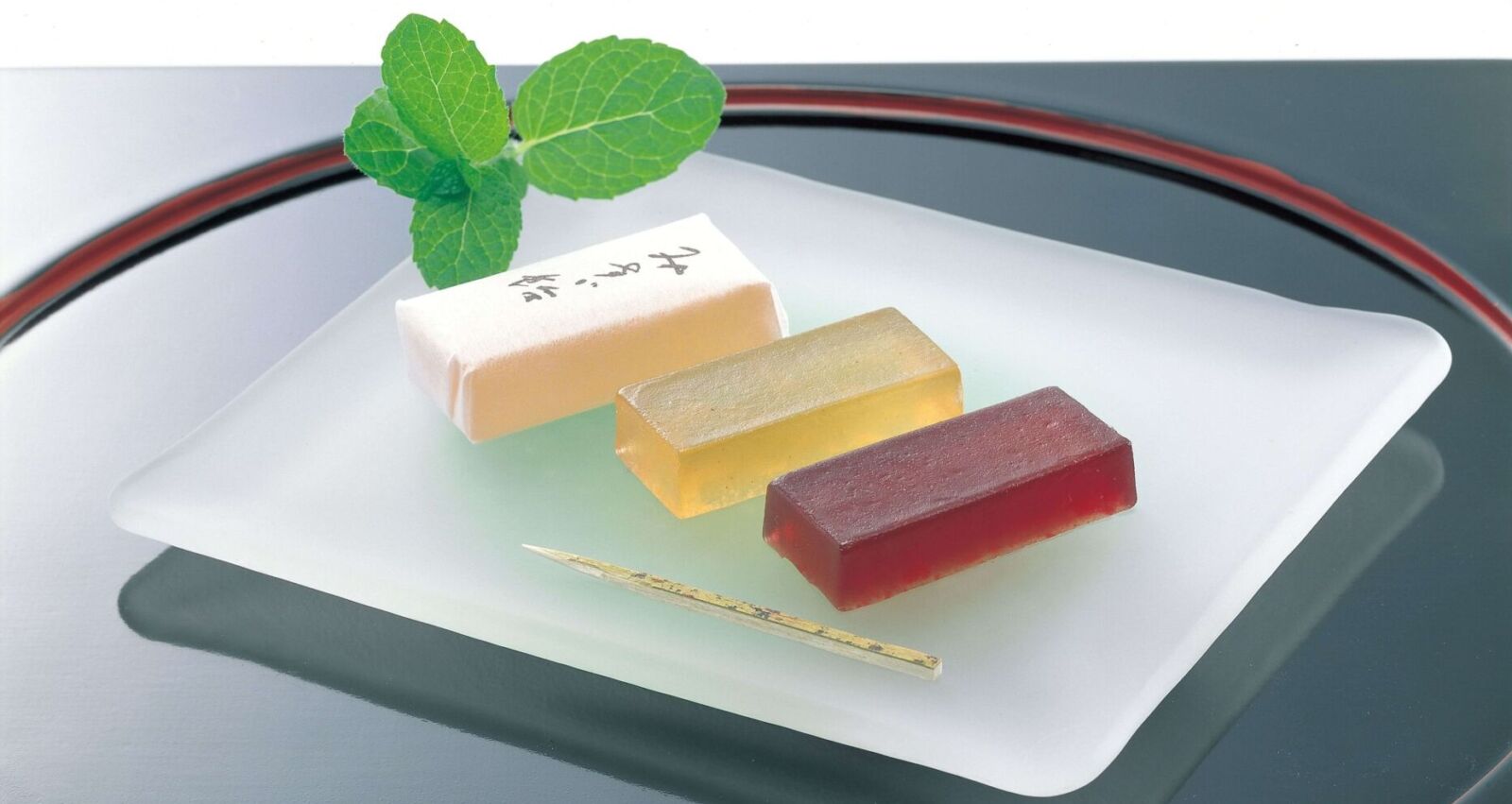
One of Ueda’s most famous establishments, Iijima Shoten is an iconic building that has been making and selling traditional ‘misuzuame’ jellies for more than 100 years. Indeed, mention of Ueda to any Japanese and there’s a good chance they’ll know of the store and long-cherished delights on sale inside. Misuzuame is produced by converting the starch within glutinous rice into sugar and flavouring it with fruit including apricot, peach, apple, grape, ‘ume’ (plum) and ‘sanpoukan’ – a large yellow citrus fruit that grows in Japan. Most famously, Iijima Shoten sells hollowed-out sanpoukan filled with jelly of the same flavour. Only 3 minutes walk from Ueda Station, enjoying the traditional sweets of Iijima Shoten is something of a must do when visiting Ueda. Open daily from 10:00 to 18:00.
17 / BAKERY LE VAIN / all year round
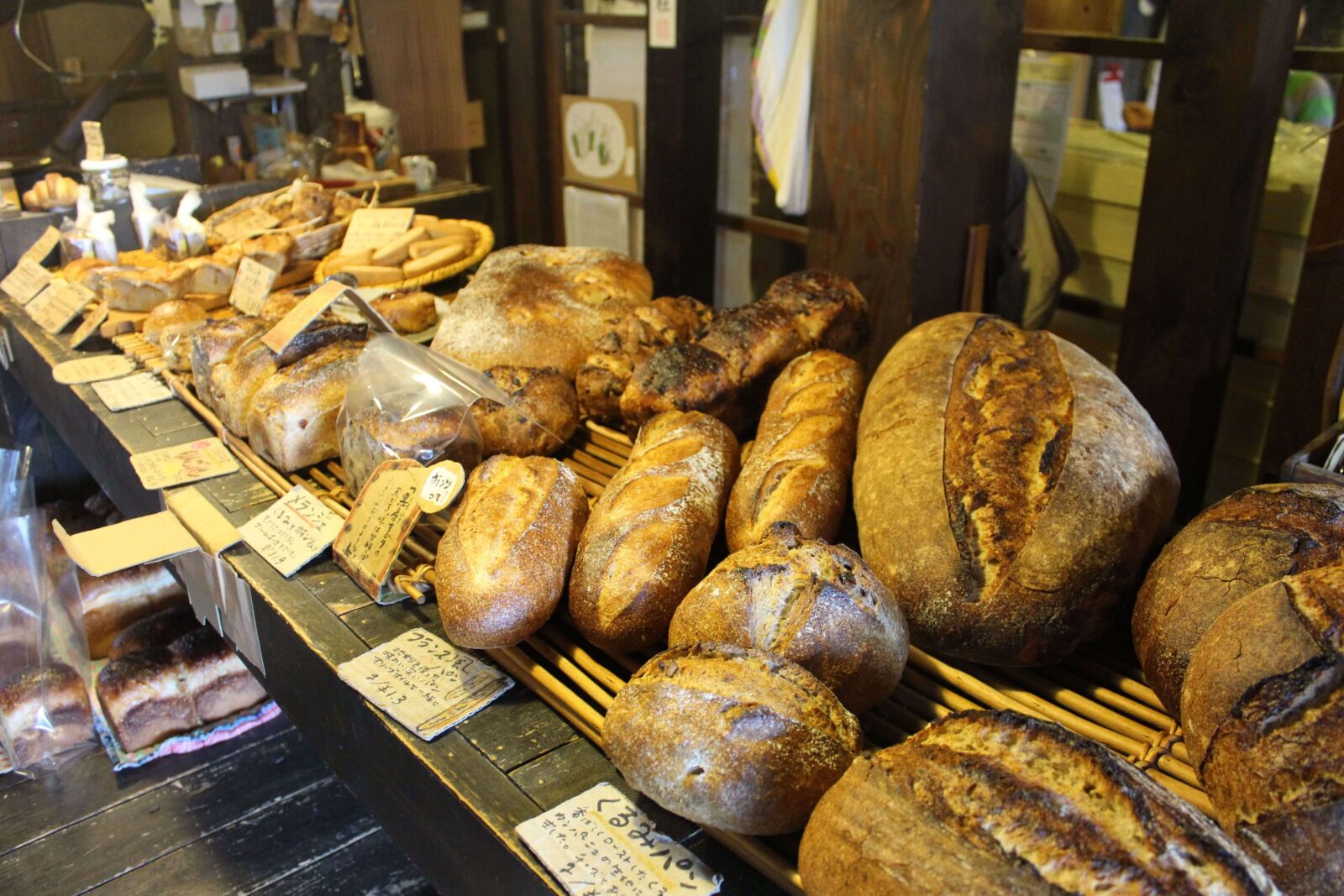
One of the most popular stores in the Yanagimachi precinct of Ueda, Bakery Le Vain is the passion of owner Koda Mikio. Koda bakes with homemade, natural yeast using a variety of local wheat, salt, water and seasonal fruits to produce truly delicious bread and pastries with seductive aromas. Use of sugar is kept to a minimum while a millstone is used to grind the whole meal flour, emphasising Koda’s commitment to healthy, traditional methods. The bakery is housed in an old merchant’s house that is a charismatic as the delicious breads on offer, with a charming second-floor space to sit on tatami and enjoy simple but delicious lunch menus. Open from 09:00 to 18:00 everyday, except Wednesday.
18 / TASTY APPLE TREATS OF UEDA / all year round
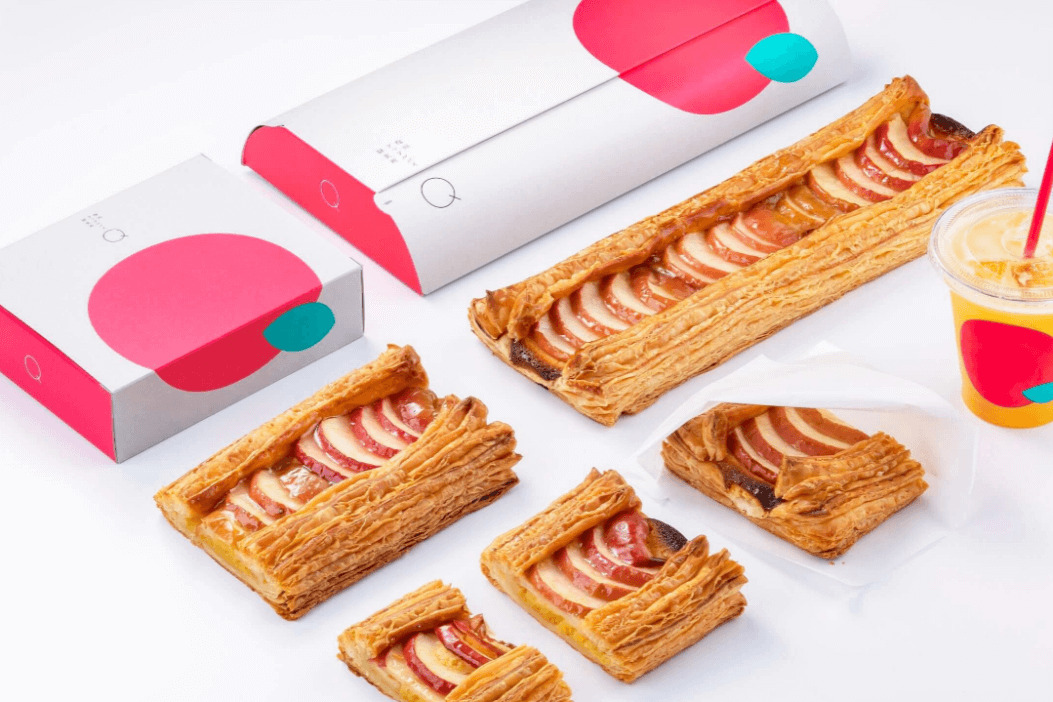
Ueda and the wider region of Nagano Prefecture have lots to offer when it comes to eating well including its delicious and very large apples. You’ll find various stores and eateries in Ueda putting its famous apples to scrumptious uses including at Co. Labo Shop, also in the Yanagimachi precinct. Open daily, other than Wednesdays, from 10:00 to 16:00, Co. Labo offers an array of tasty treats including apple egg tarts, apple ‘dorayaki’, baked apple doughnuts, ‘ringo monaka’ (apple cake) and more! The distinctively named Shinshu Apple Pie Laboratory is another local favourite, serving its signature apple pie in 2, 3, 6 and 12-inch lengths and beautifully designed boxes along with delectable apple juice. Open daily other than Tuesday, from 10:00 to 18:00, Shinshu Apple Pie Laboratory is only a short walk from the Fukuromachi district.
19 / AYU RAMEN / all year round
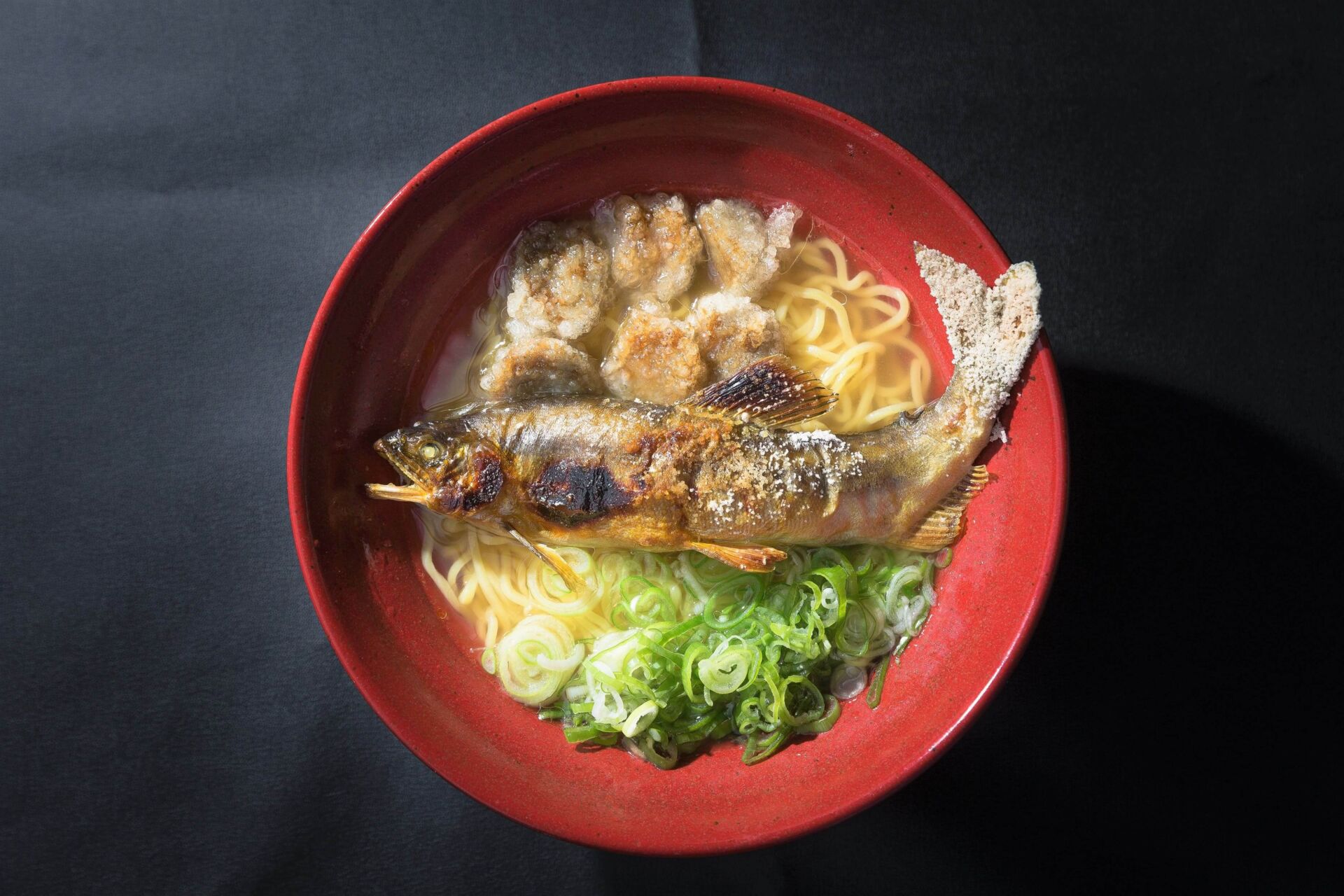
One of Japan’s most popular dishes, ‘ramen’ is a ubiquitous staple with countless regional varieties waiting to be discovered across the country. Ramen-lovers headed to Ueda are in for a treat with local restaurant ‘Koinishi’ serving their speciality ‘ayu ramen’ – a delectable bowl of ramen served with a whole grilled ayu fish. The soup is ayu-based with the whole fish also complemented with ayu dumplings. Served in red bowl – the distinctive colour of the Sanada clan’s ‘Akazuke’ red armour – ayu ramen is reflects both the history and traditional flavours of Ueda. Koinishi is open daily from 09:00 to 19:00, only moments walk from Ueda Station.
20 / UTSUKUSHIGAHARA KOGEN INC. OPEN-AIR MUSEUM / all year round
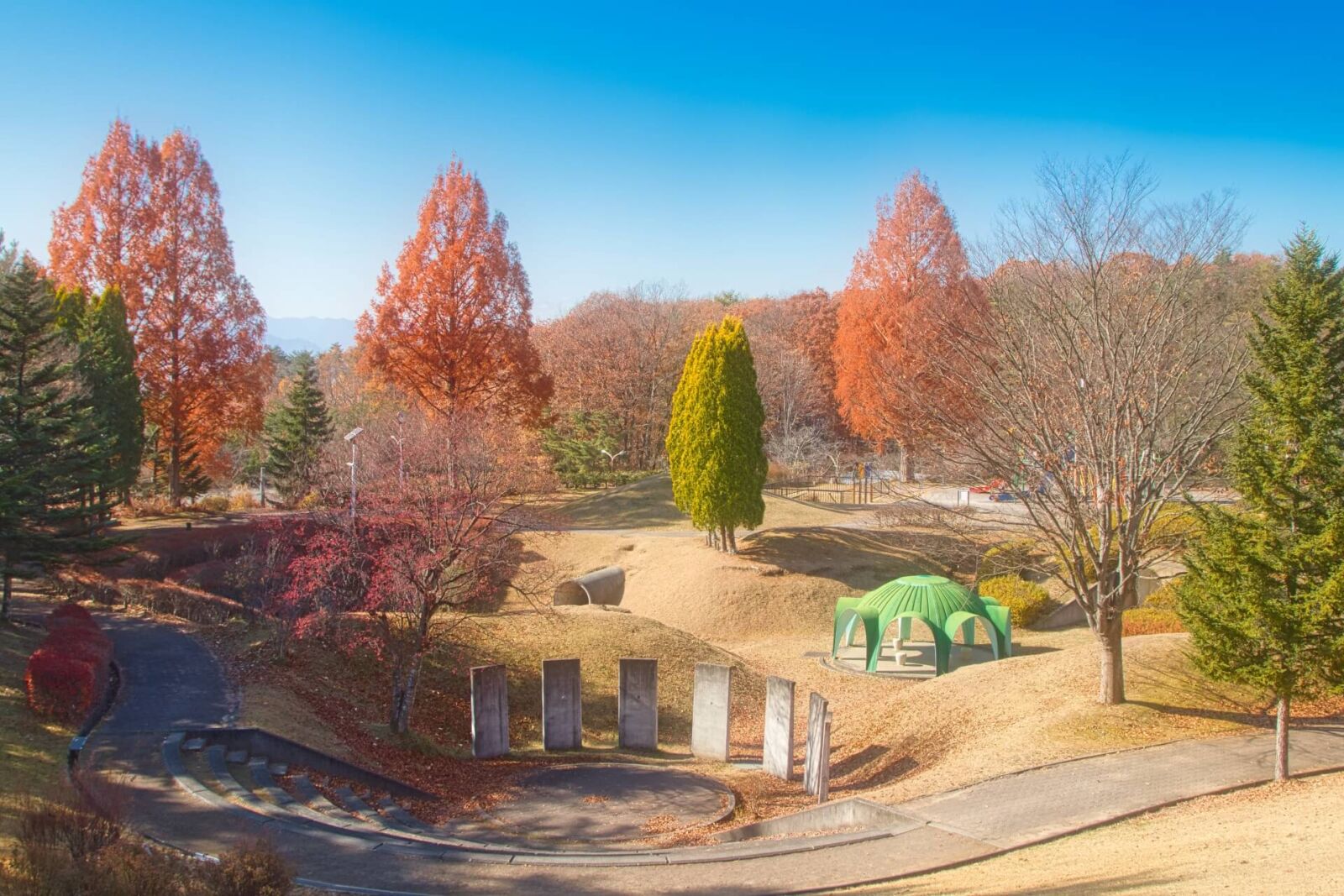
Part of the broader Yatsugatake Chushin Kogen Quasi-National Park, Utsukushigahara Kogen or ‘Utsukushigahara Highlands’ ascends to over 2000 metres above sea level; an area known for its seasonal beauty and beautiful star-filled sky at night. The area is largely devoid of trees with its hiking trails offering leisurely walking across open grasslands and through wild flower fields – with over 200 varieties known to grow on the alpine plateau. Walking trails suitable to anyone of reasonable fitness span-out across highlands that continue their use as alpine pastures for grazing cattle. On clear days you can see Mount Fuji to the south and Mount Asama – another of Japan’s most active volcanoes to the east; while at night, the spectacular star-filled sky attracts visitors from all over Japan. Located with the highlands, Utsukushigahara Open-Air Museum is a notable attraction, featuring 400 modern and classical sculptures and outdoor installations. Notable works include Alexander Liberman’s ‘Iliad Japan’, Cesar Baldaccini’s ‘Thumb’, Bernhard Luginbühl’s ‘Gun for Sparrow Osaka Punch’ and many others. The museum is open daily from late-April until mid-November from 09:00 to 17:00.
21 / VISIT KARUIZAWA / all year round
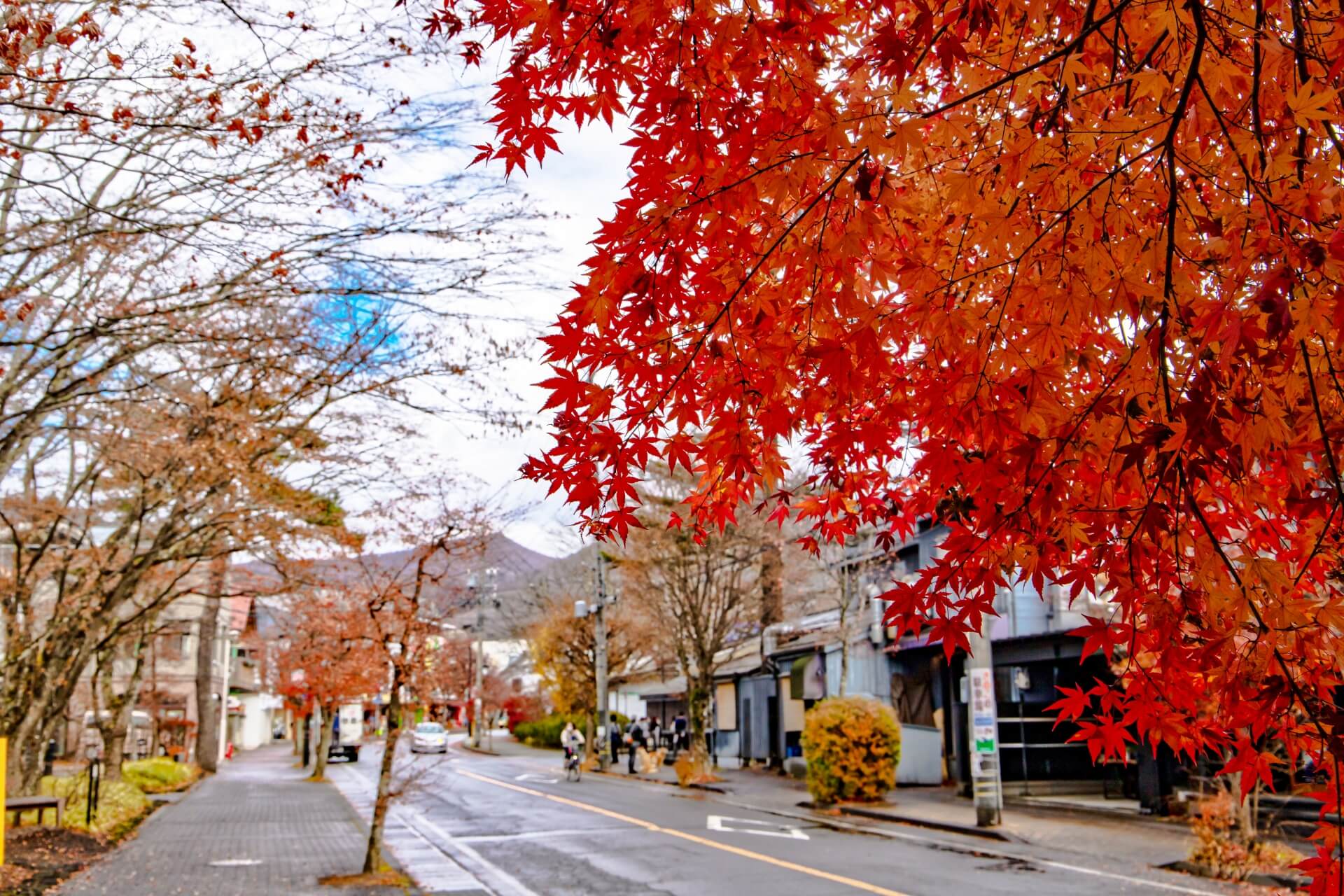
Only 15 minutes from Ueda using the Hokuriku Shinkansen - or 60 minutes using the Rokumon Sightseeing Train, see below for details - Karuizawa is one of Japan’s oldest and most famous mountain resort towns. Known for its shopping outlets, fine dining, museums, galleries and high-end accommodation, Karuizawa is popular with Tokyoites who head there throughout the year but especially in summer, when the cool mountain climate offers a welcome escape from the heat and humidity of the city. Also famous for its beautiful autumn leaves and winter snow activities, Karuizawa is an ideal destination to combine with your visit to Ueda.
22 / VISIT NAGANO / all year round
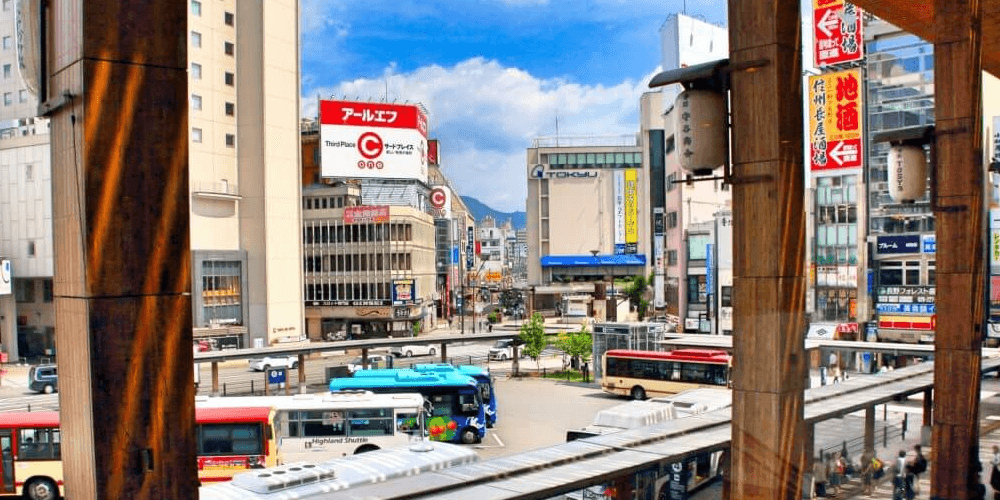
Visitors to Ueda are also within easy reach of Nagano City. Home to the near-1400 year old Zenko-ji Temple, Nagano is serviced by the Hokuriku Shinkansen or the Rokumon Sightseeing Train – see below for details – connecting it to both Ueda and Karuizawa. As such, it’s the ideal end point for one of the region’s best mini-tours and further launching from where to explore the northern reaches of Central Japan including its many world-class ski resorts and of course, the Jigokudani Monkey Park. Within the city itself, Zenko-ji Temple stands alone as the main attraction and spiritual heart of the region while the forest shrines of Togakushi and hidden samurai town of Matsushiro are all accessible using local buses.
23 / JIGOKUDANI MONKEY PARK / all year round
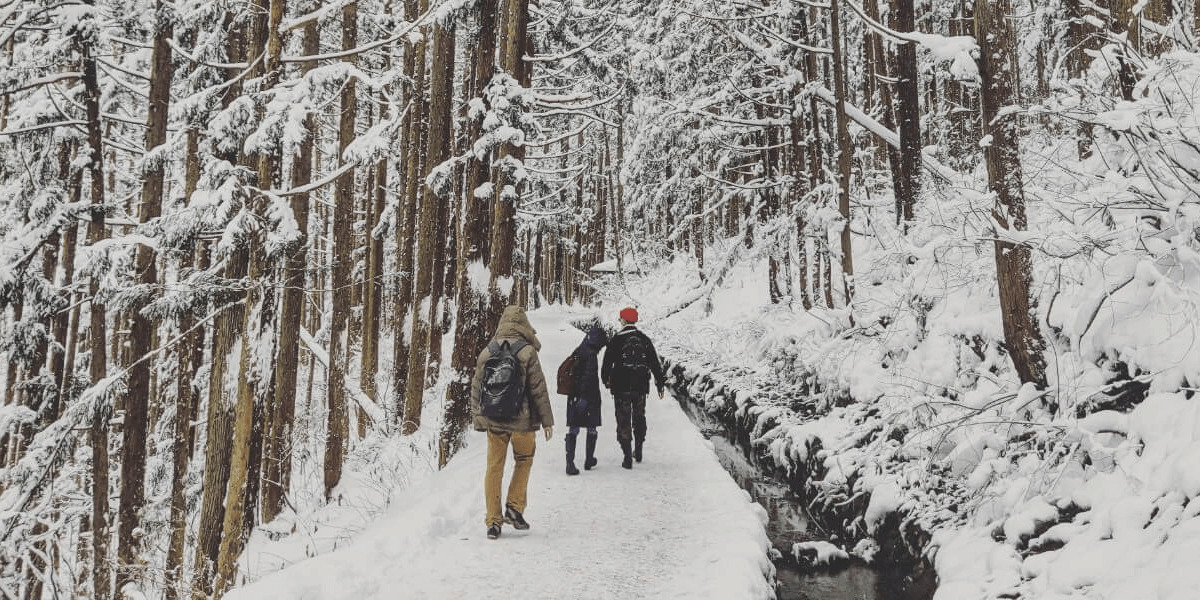
As the unofficial mascots of Nagano Prefecture, there are few things in nature more heart-warming than the site of the ever-adorable snow monkeys, soaking in their hot onsen baths to get a temporary respite from the cold winter chills. The Jigokudani Monkey Park – less than 60 minutes from Nagano City - offers the perfect opportunity for visitors to see these wonderful creatures up close and personal in their own habitat. Unlike many other nature reserves or safari parks, you can freely move amongst the monkeys and see how they go about their daily lives in this beautifully unspoiled landscape. Want to visit the park on a guided tour? We offer both group and private tours all year round and can arrange a visit to the monkeys in combination with other great destinations, accommodation and restaurants. For more information, see ‘Book With Us! Nagano’s No.1 Tour & Charter Operator’ below.
24 / TATEYAMA KUROBE ALPINE ROUTE / April to November
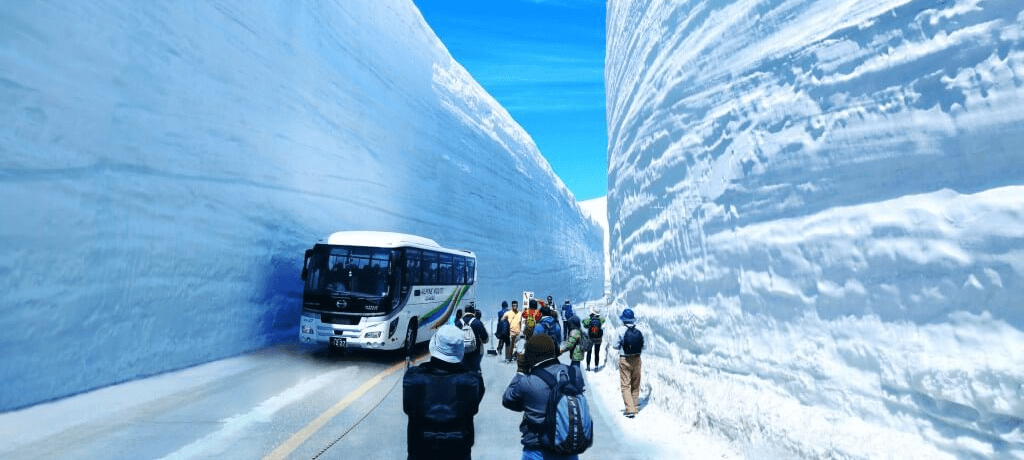
Popular
[Spring Only] 1-Day Tour from Nagano: Snow Walls of Tateyama-Kurobe Alpine Route
- Spots:
- Pick-up:
- Drop-off:
Heralded as one of Japan’s best experiences, traversing the Tateyama-Kurobe Alpine Route takes approximately 6 hours without allowing for time to stop and enjoy all of its stunning sights. In reality, undertaking a visit to the Alpine Route is therefore a full-day activity. Visitors can start from Nagano via Ogizawa Station or Toyama via Tateyama Station, and choose to finish on the other side or return to their point of origin. A series of mountain transports including trolley buses, cable cars, a ropeway, and coaches transport visitors to and from Murodo Station – which at 2540 meters is the highest station in Japan. Open from mid-April to mid-November, the Alpine Route is most famous for its immense snow walls which, at their peak, ascend 20 meters above the road below. The walls are at their best from the opening day in April until late-June, after which outstanding hiking is available through summer and autumn, climaxing with stunning autumn colours in October until the route closes again in November.
25 / ROKUMON SIGHTSEEING TRAIN / all year round
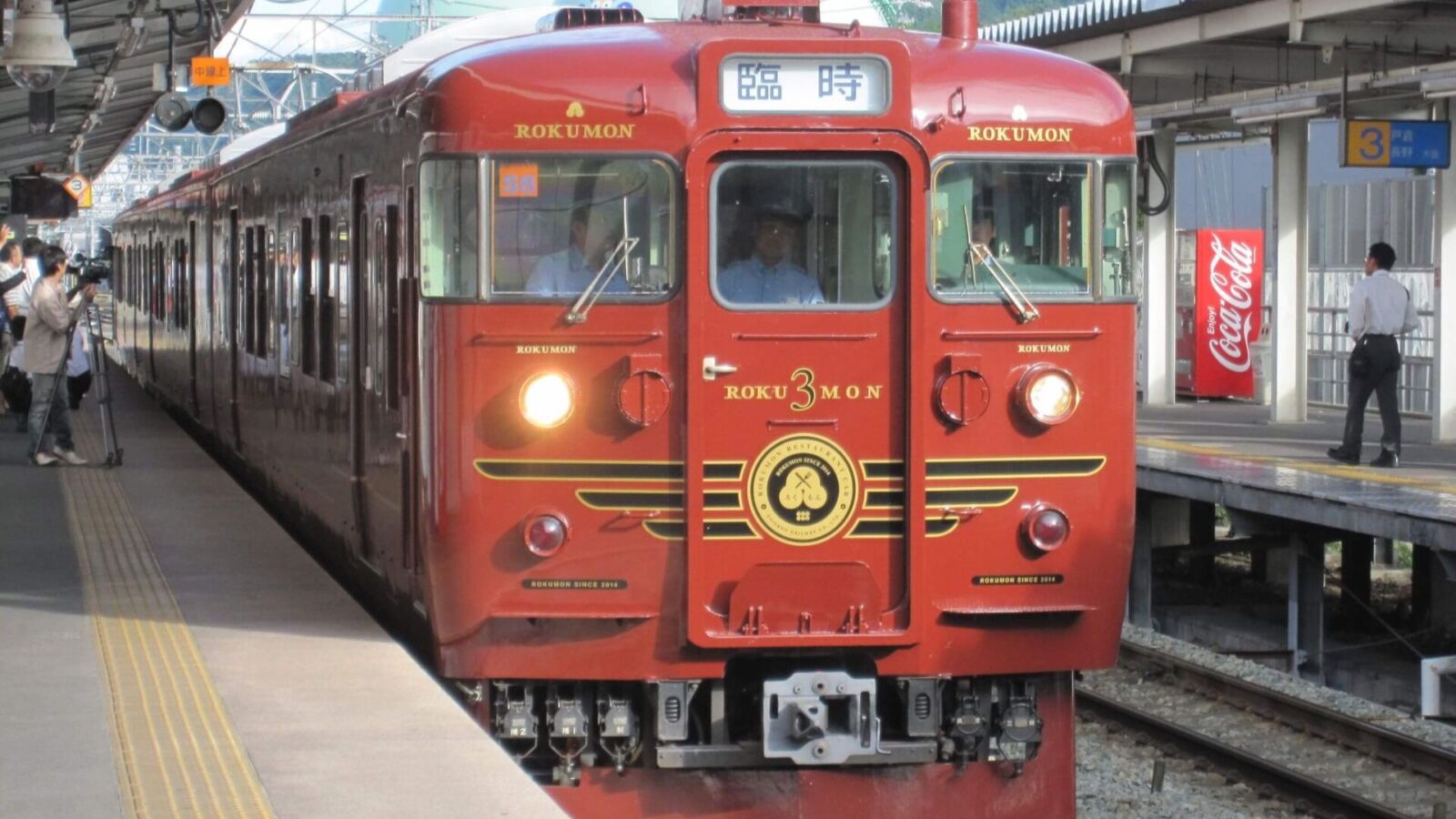
Running from Karuizawa to Nagano via Ueda, the Rokumon Sightseeing Train is one of the most enjoyable ways to journey through the region while connecting three of its most rewarding destinations. Taking 2.5 hours to cover the journey from Karuizawa to Nagano, the three-carriage sightseeing train features local timber throughout instilling the experience with a relaxing and classic atmosphere. Depending on your preference, you can choose between menus of which the ’kaiseki’ (multi-course) Japanese menu and Western menu paired with local wine are highlights. The train takes its name from the distinctive six coin emblem of Ueda’s Sanada clan, almost compelling you to disembark at Ueda to visit the castle park and any of the attractions listed above. The train runs from March to September, with two services each day from Nagano and Karuizawa. Reservations can be made through the official website.
BEST PLACES TO STAY IN UEDA & BESSHO ONSEN
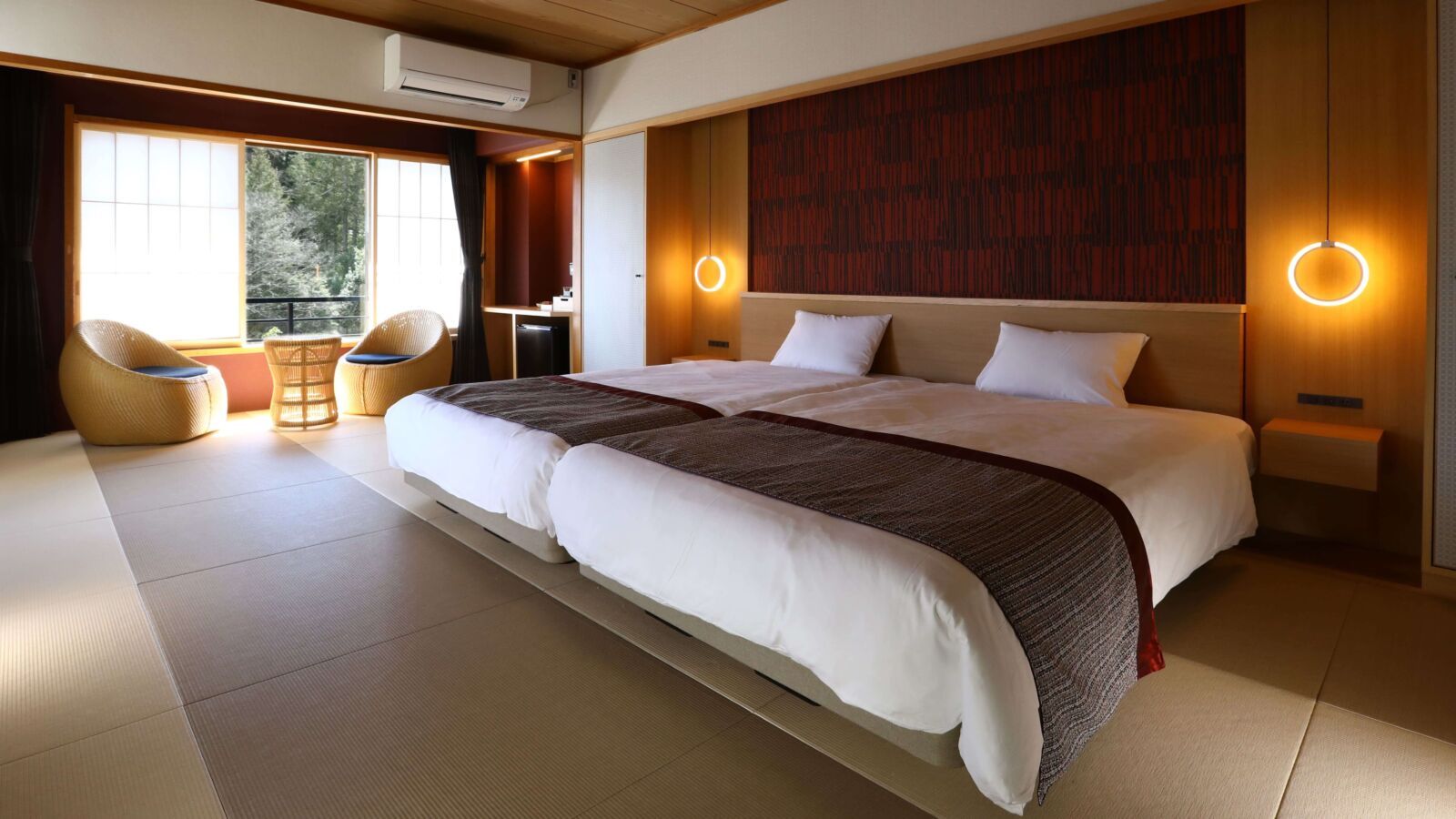
Visitors to the Ueda and Bessho Onsen area can choose between a range of accommodation including Western-style hotels, hot spring guesthouses, ski lodges and more. Accommodation is dotted throughout the area with the largest concentration of hotels and guesthouses in the following areas:
UEDA CITY
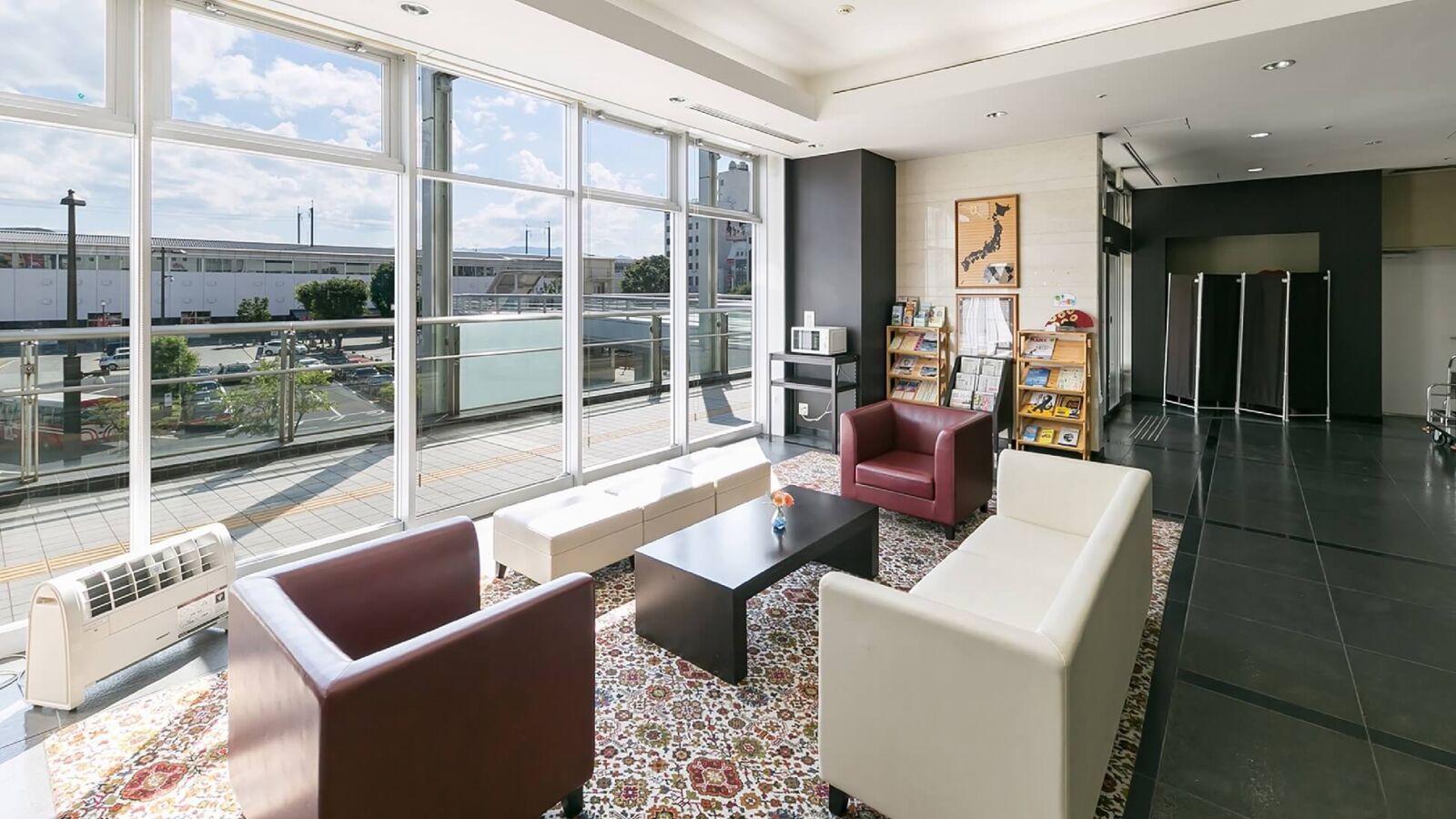
Visitors travelling to and from Ueda by train, and prioritising ease of access when looking for accommodation, should consider staying around Ueda Station. In that area you will find multiple business and other Western-style hotels providing easy access to the station and attractions including Ueda Castle Park, Yanagimachi, Fukuromachi and many of the destinations listed above. For accommodation listings, see the 'Ueda City Centre' hotel page.
BESSHO ONSEN
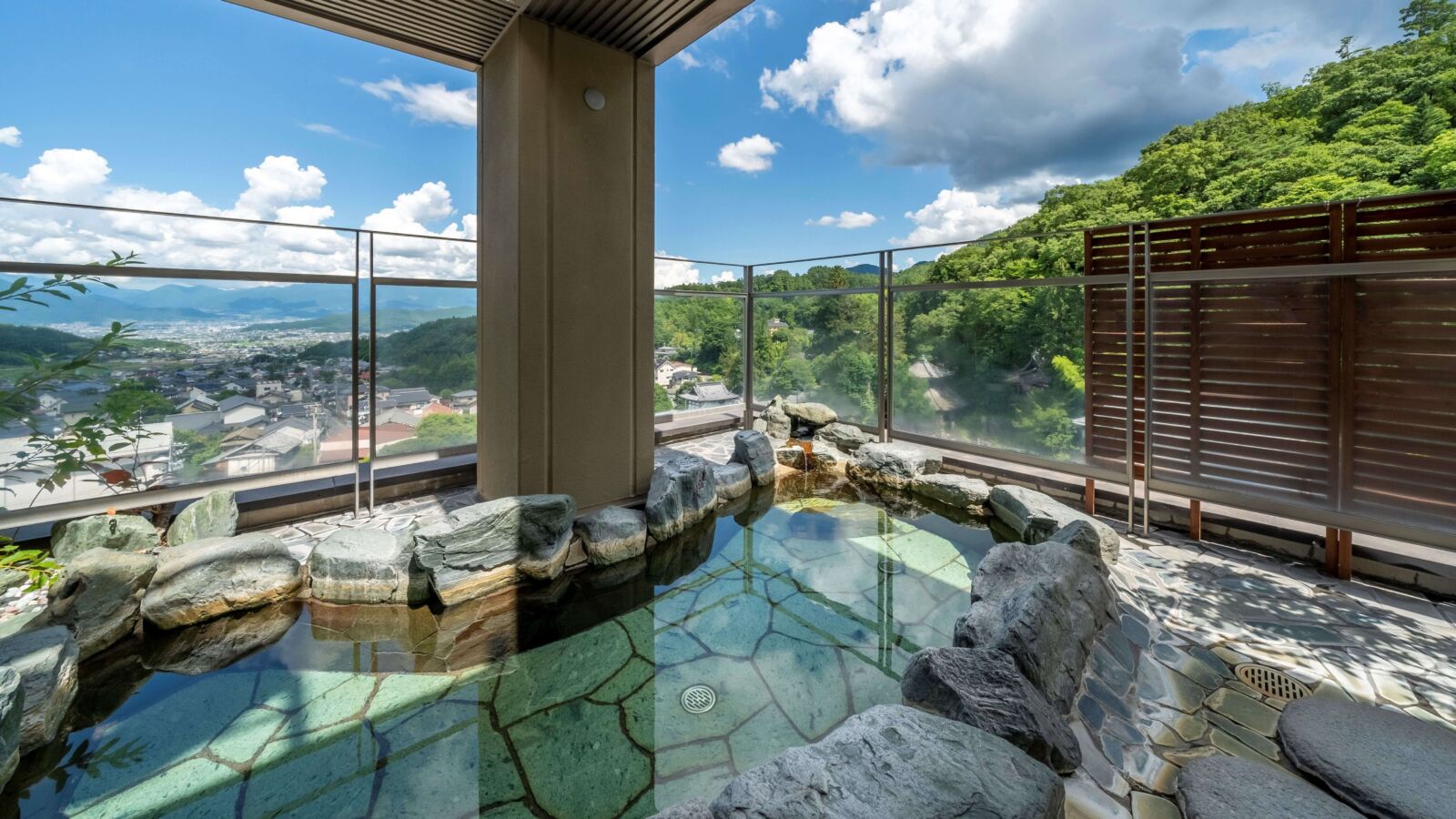
The hot spring town of Bessho Onsen is only 30 minutes by train from Ueda Station. Famous for its many ‘onsen’ (hot springs) and temples, staying in Bessho is a great option of travelers wanting to enjoy the traditions and comforts of a hot spring guesthouse. There are plenty options to choose from including high-end, mid-range and budget options. One thing to note is that many if not most accommodation in Bessho Onsen include Japanese-style rooms including on-floor ‘futon’ bedding, low furniture and shared bathrooms. If that is an issue for you, make sure to check the features of your chosen hotel prior to booking. For accommodation listings, see the 'Bessho Onsen' hotel page.
SUGADAIRA KOGEN
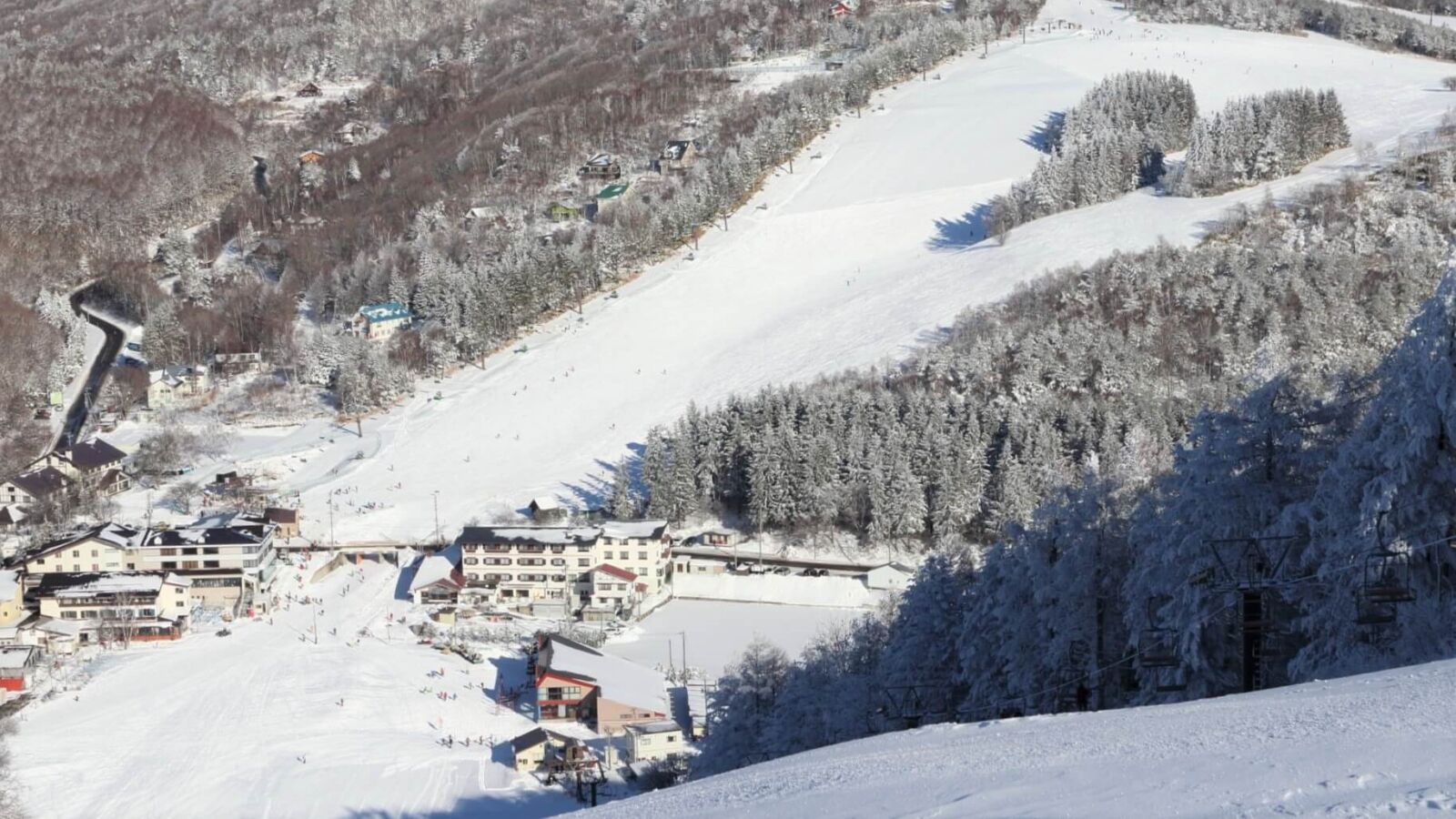
Sugadaira Kogen is located around 60 minutes drive from Ueda Station, home to one of Nagano’s largest ski resorts and highlands sports venues, farms and plenty of accommodation. Hotels and lodges are dotted across the highlands, largely centred around the three areas of the ski resort – Taro, Davos and Pine Beak. Options range for large hotels to small, family-run lodges. As detailed on our Sugadaira Kogen Snow Resort page, the overall ski resort is best-suited to beginner skiers and boarders or anyone looking for a more ‘authentic’ Japanese ski experience away from the crowds of Hakuba and Nozawa Onsen. For accommodation listings, see the 'Sugadaira Kogen' hotel page.
UTSUKUSHIGHARA KOGEN
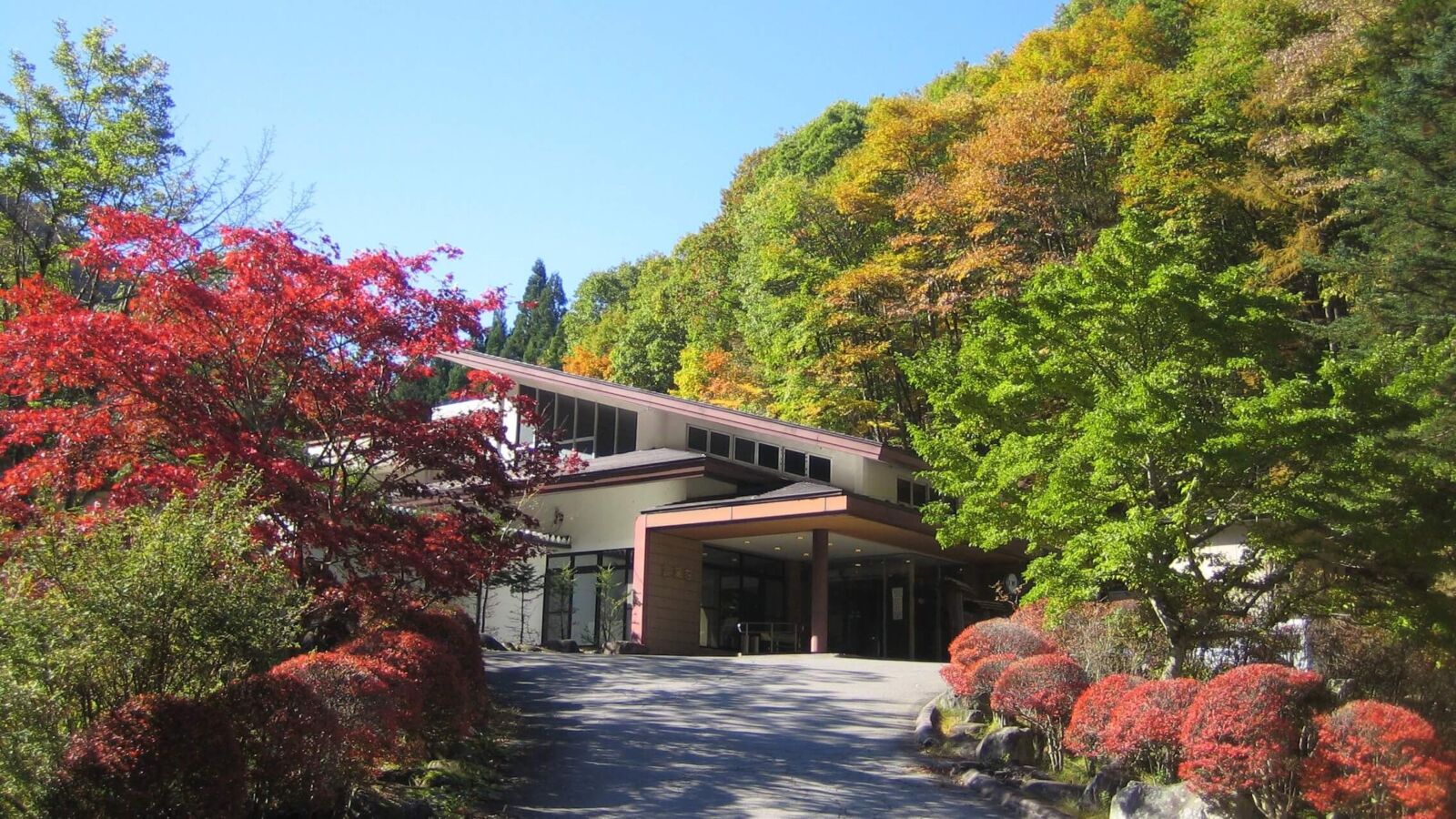
Around 70 minutes drive from central Ueda City, Utsukushighara Kogen is another beautiful highland area known for its leisurely walking trails, panoramic views, star-filled night sky and Utsukushigahara Open-Air Museum. There’s a small amount of accommodation to choose from in the area including a couple of hotels and campgrounds. For accommodation listings, see the 'Utsukushigahara Kogen' hotel page.
HOW TO GET TO UEDA & BESSHO ONSEN
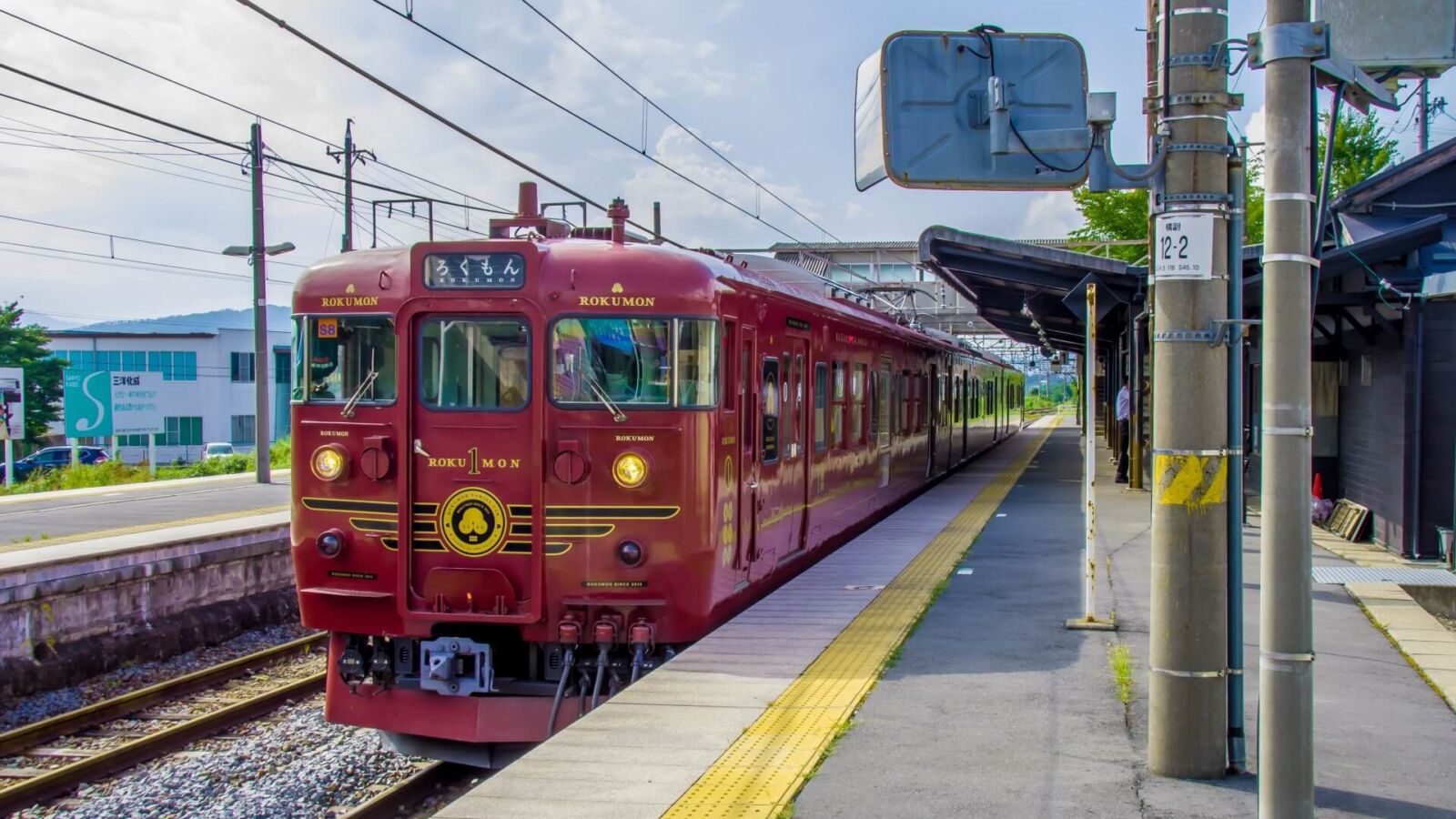
As a stop on the Hokuriku Shinkansen line running from Tokyo to Kanazawa, Ueda is quick and easy to reach including from nearby Nagano and Karuizawa, or should you wish to go slow, using the Rokumon Sightseeing Train. Our 'How to Get to Ueda & Bessho Onsen' page has directions of just how to get there from those and other popular starting points.
TOURS AND CHARTERS AROUND UEDA & BESSHO ONSEN
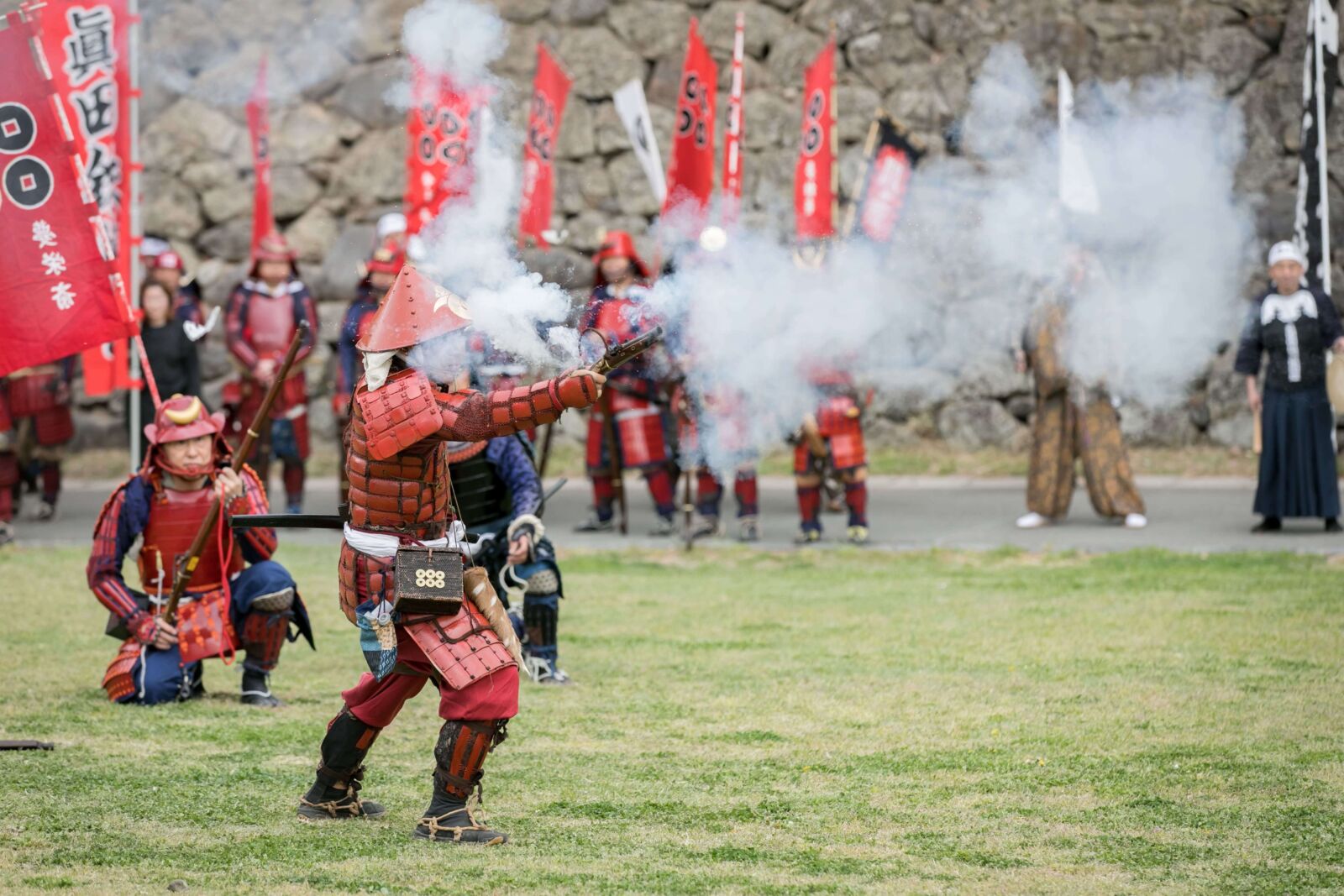
With so much to see in Ueda and its surroundings, taking part in a tour is a great way to make the most of your day. As Nagano's No.1 Tour Provider, we are glad to offer our services in the way of group tours, private tours, and private charters, and will always do our best to make your visit unforgettable. For more information concerning these services, continue reading below.
Combining Snow Monkeys and Cherry Blossoms, two of Japan's biggest international hits, this tour is an easy way to enjoy the Spring season without worrying about confusing transport options. Our bus will take you to all of the destinations along the way, and our guides will make sure that you enjoy each stop. As the peak bloom of the blossoms is hard to predict, we change the location of the cherry blossom visit based on the day, and one of those locations is Ueda Castle. Although we cannot guarantee that the day of your visit will include Ueda Castle, we can guarantee that you will enjoy yourself no matter where we end up!
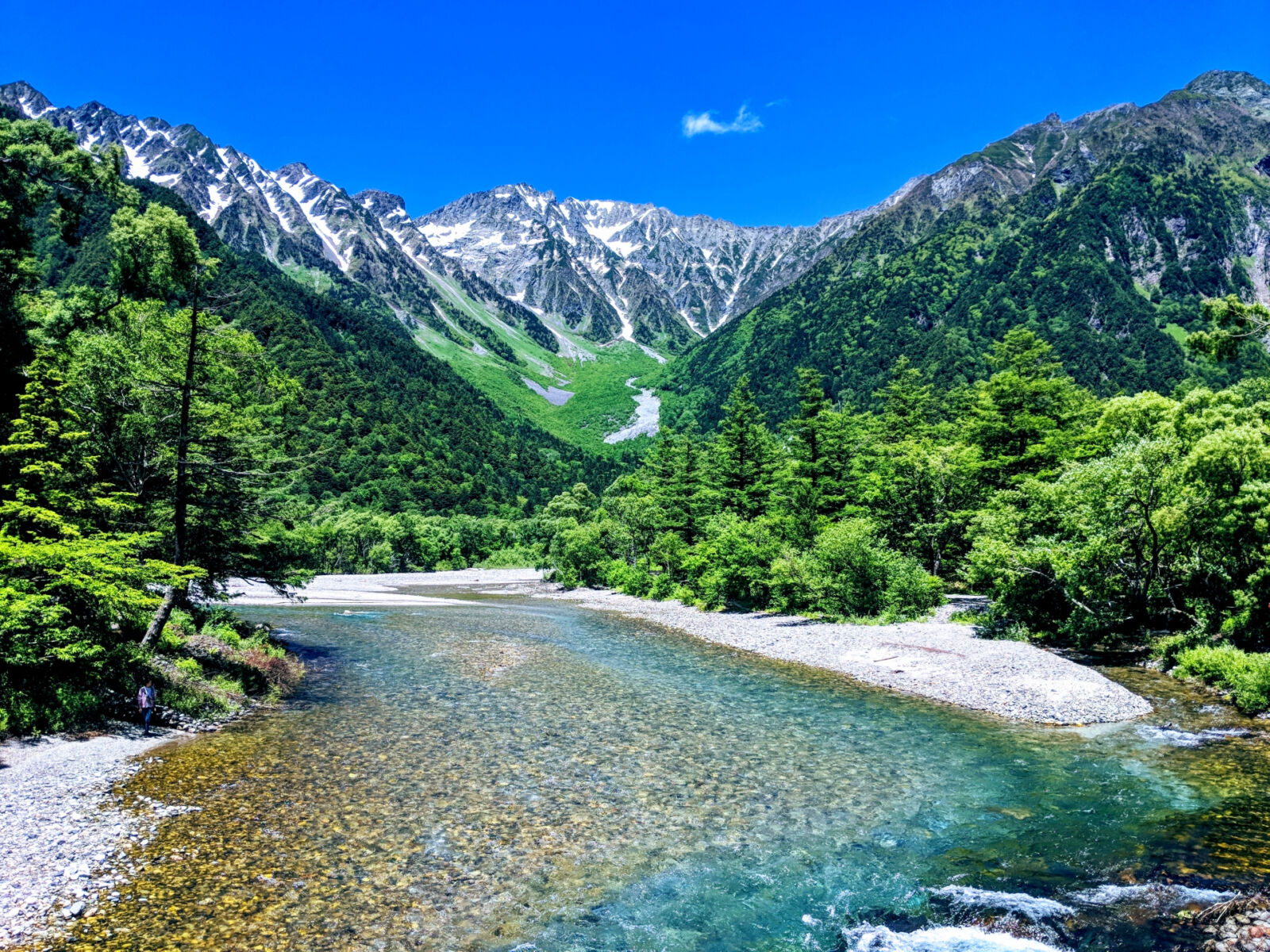
With such easy access by bullet train between Ueda and Nagano, Karuizawa, and other popular areas, it is simple to join tours taking place around the Nagano Prefecture even for a day trip from Ueda. Most tours offer pickup from Nagano Station, which is only 15 minutes from Ueda and serves as a great center point for more activities than you may expect. For a complete run down, please see our page 'Best Tours in Nagano' for a detailed list of everything we have on offer here.
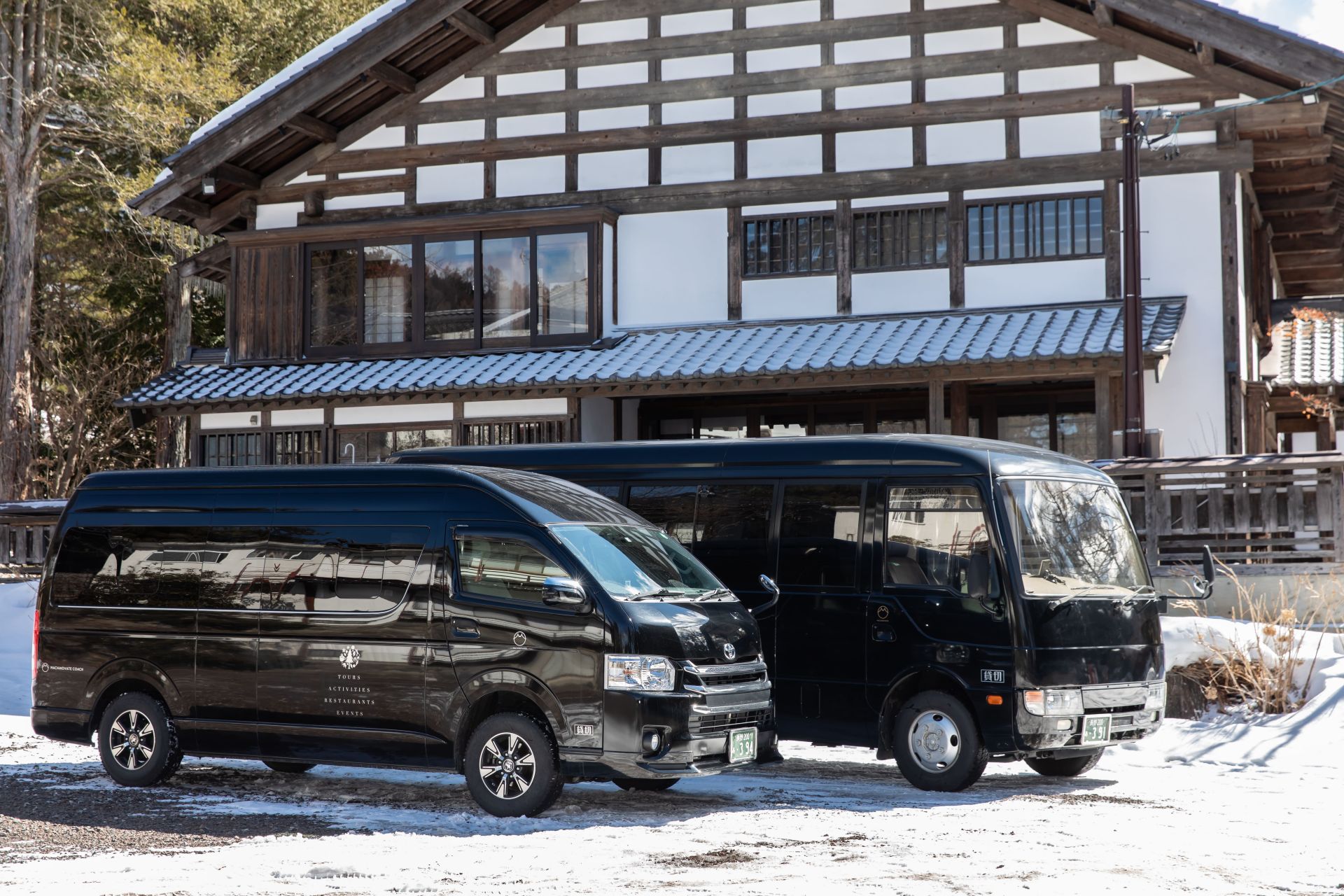
For a more personalized experience, private charters are also available. We can pick you up from a location of your choice anywhere in Central Japan, and bring you to your preferred destination. Airport pickup from Tokyo or Nagoya is also possible. Our services may be used for taking day trips that include a few hard to reach destinations as well, removing the hassle of using often infrequent public transport options. A guide can be requested for an additional fee to turn the day into a completely private tour, where you decide the itinerary and our guides show you around in a timely and engaging manner. For more information concerning pricing and availability, please see here.














